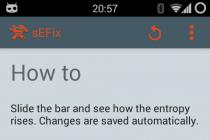I remember well the days when 5-inch gadgets were called tablets, and the very first Samsung Galaxy The 5.3-inch Note was considered an "uncomfortable shovel" and laughed when photographed with it near the ear. Now even huge smartphones do not cause a smile. One of them, the 6.44-inch Xiaomi Mi Max 2, was tested by us.
What's new compared to Mi Max?
Mi Max 2 came out exactly one year after the first giant Xiaomi - Mi Max. However, the evolution turned out to be very specific. Look detailed specifications two devices in the table below:
| Smartphone | Xiaomi Mi Max | Xiaomi Mi Max 2 |
| Display | 6.44 inches, IPS, 1920 × 1080 | 6.44 inches, IPS, 1920 × 1080 |
| CPU | Snapdragon 650, 6 cores, 1.8 GHz | Qualcomm Snapdragon 625, 8 cores, 2 GHz |
| Graphics | Adreno 510 | Adreno 506 |
| RAM | 3 GB | 4 GB |
| Memory (RAM / ROM) | 32/64/128 GB, microSD | 64/128 GB, microSD |
| Front-camera | 5 MP, f / 2.0 | 5 MP, f / 2.0 |
| Main camera | 16 MP, f / 2.0 | 12 MP, f / 2.2 |
| Battery | 4850 mAh | 5300 mAh |
| Dimensions, weight | 173.1 x 88.3 x 7.5mm, 203g | 174.1 x 88.7 x 7.6mm, 211g |
As you can see, the new product received an even weaker processor than its predecessor, became a little larger and heavier.
But do not forget about the peculiarity of this, albeit less powerful, processor - it is very energy efficient. In addition to the increased battery capacity with an unchanged display, this should have a very positive effect on time. autonomous work devices.
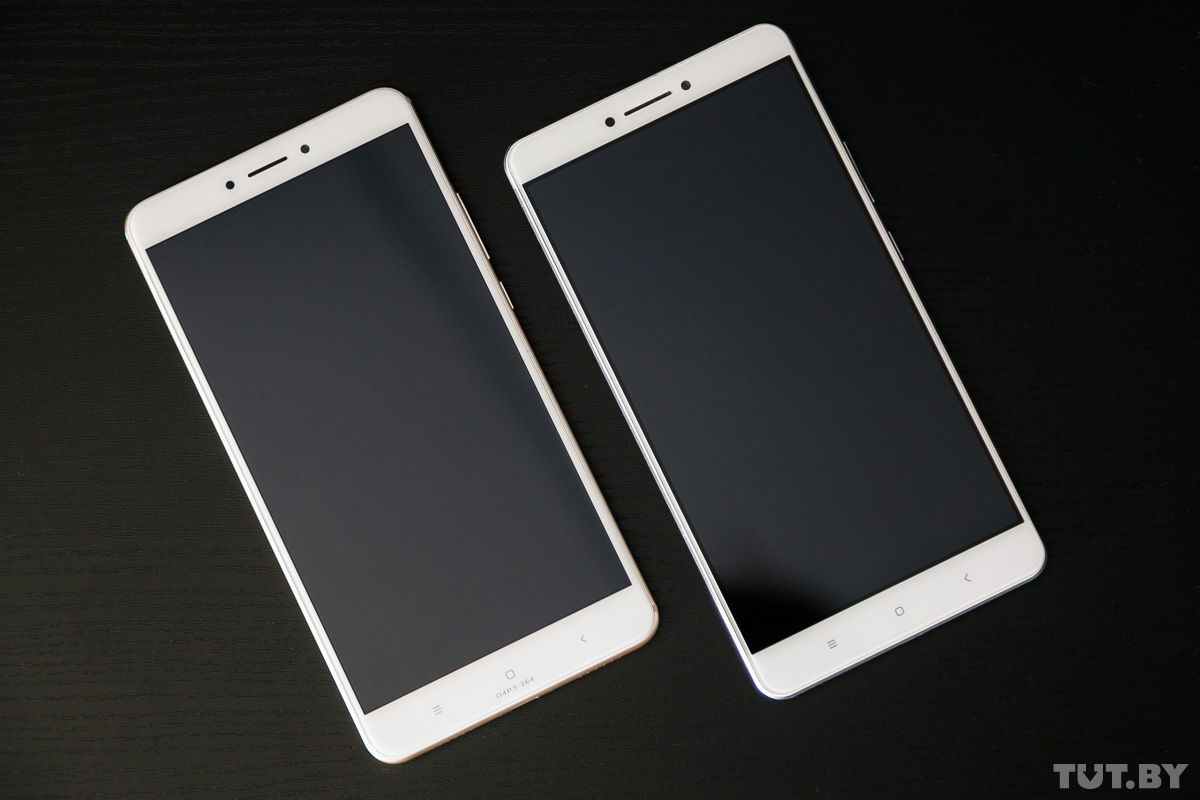 Mi Max 2 (left) and Mi Max
Mi Max 2 (left) and Mi Max 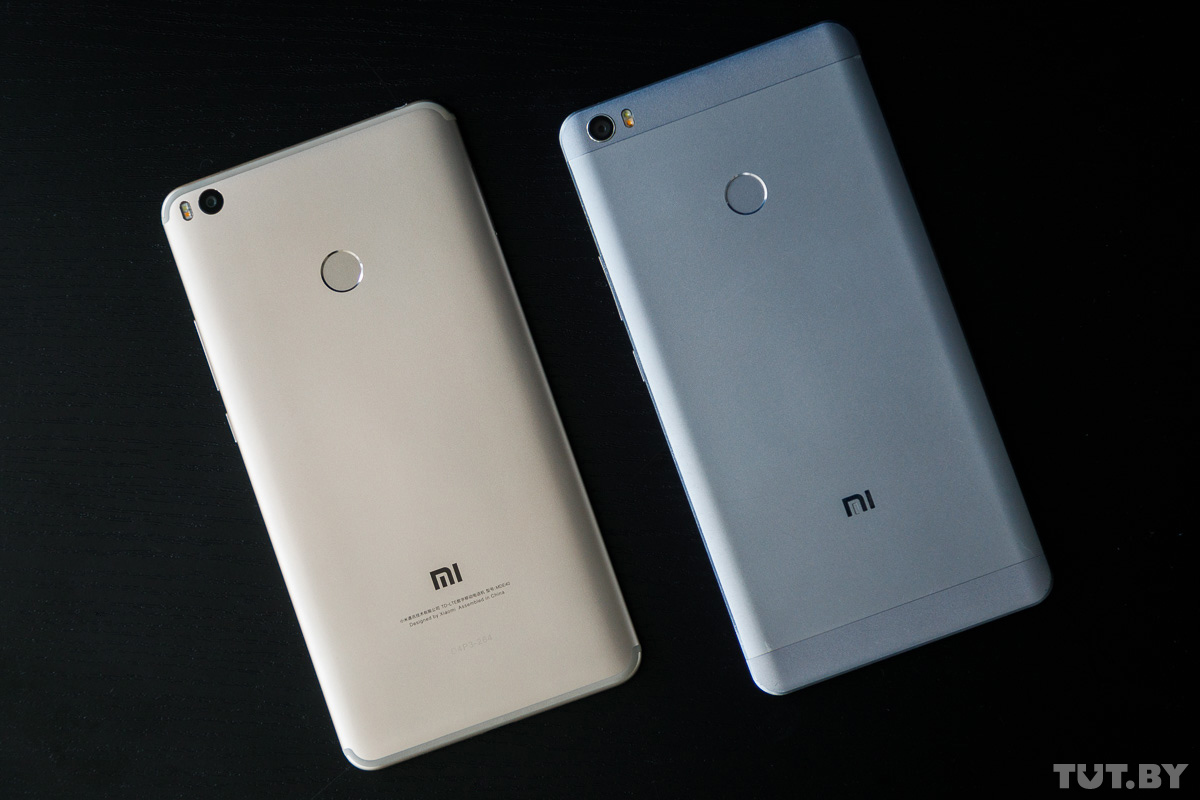 Mi Max 2 (left) and Mi Max
Mi Max 2 (left) and Mi Max If we compare the two devices, we will add a slightly more ergonomic design to the advantages of the novelty (thanks to the rounded shape, Mi Max 2 does not cut into the palm), as well as an increased amount of RAM and permanent memory (in the “base”).
Xiaomi Mi Max 2 is somewhat reminiscent of the iPhone 7, only as if flattened under pressure. Here are the same round ends, a similar charging port surrounded by screws and holes in the speakers, as well as antennas that have "gone to the ends." However, a similar similarity.
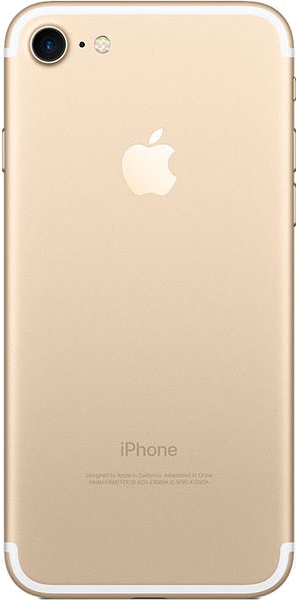
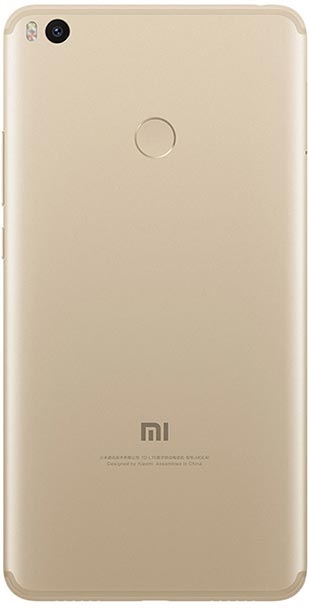
The body is metal, monolithic, the screen is protected by Gorilla Glass 4, slightly rounded towards the ends (2.5D). On the right side there are buttons, elastic with good travel, on the left - a hybrid slot (microSIM + microSD or microSIM + nanoSIM). Unlike last year's smartphone, it already uses a USB Type C connector, not microUSB.
![]()
Due to the specific size, using the smartphone with one hand will be problematic, in almost all cases you will have to use the other. However, this should already be obvious to people buying such a device.
The increased size also negatively affects the use of the fingerprint scanner at the back - sometimes you have to intercept the hand.
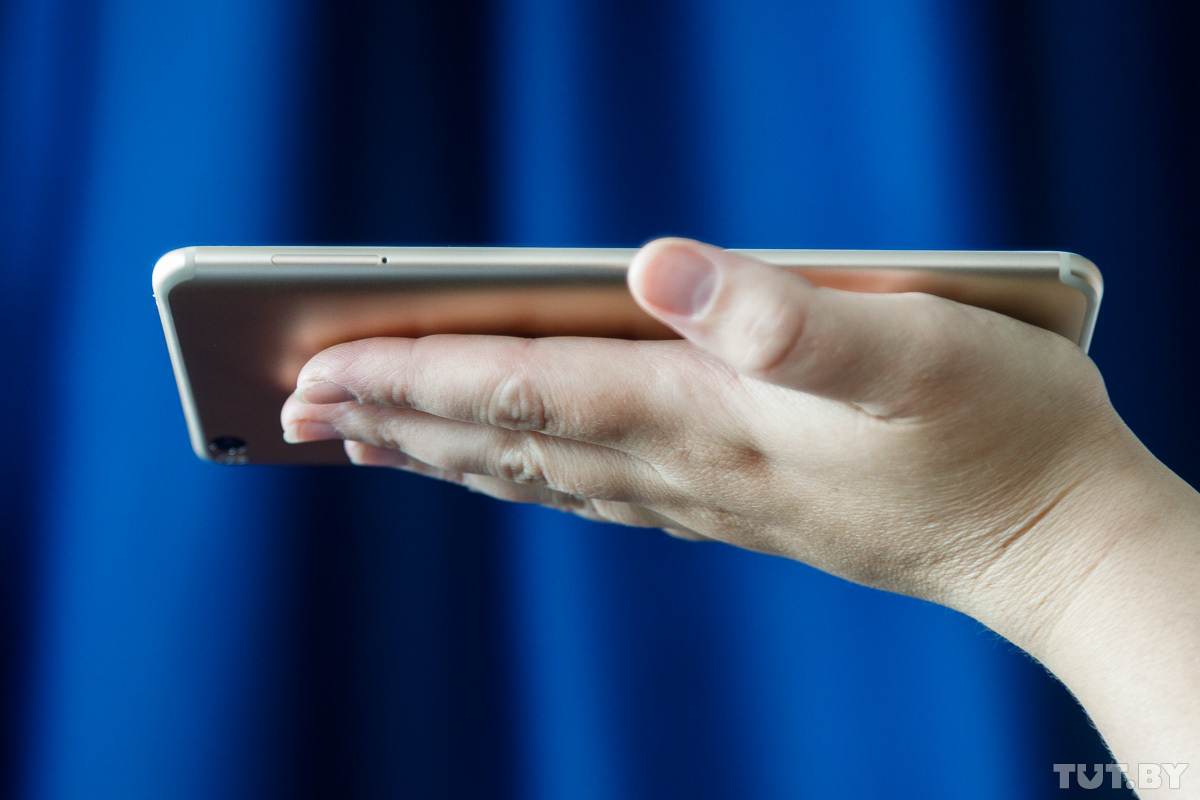
Crisp, but not the best screen
Full HD resolution is enough for a 6.44-inch matrix, and the pixels, if you don't look closely, are not noticeable. There are no particular complaints about color rendition, contrast and oleophobic coating either.
But the brightness could be better. There are no problems indoors, but in the sun (which sometimes appears in Belarus) the picture fades. In addition, the screen darkens noticeably with a more or less strong tilt.
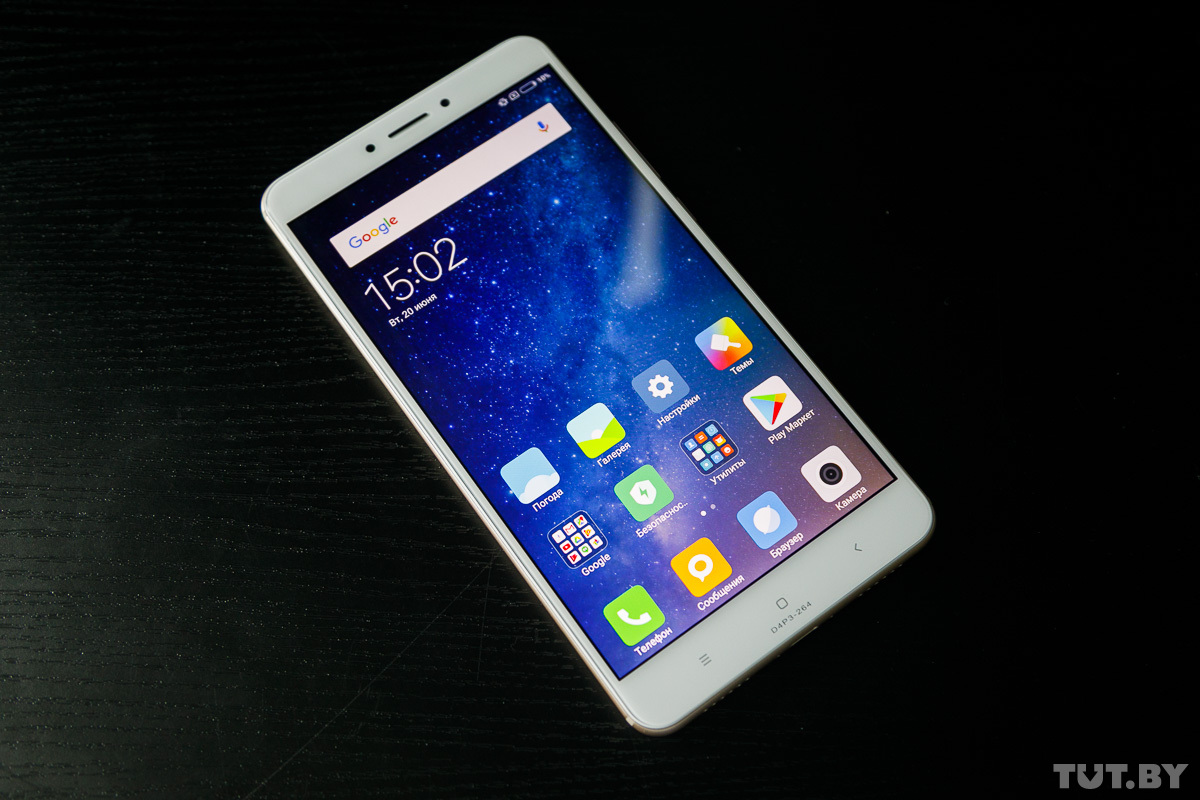
Balanced hardware and incredible battery life
Do not rush to scold Xiaomi for downgrading the processor - its power will be enough for you for most tasks!
Even if he does not set records in AnTuTu - more precisely, his performance there is very modest, but he completely pulls out "tanks" at maximum settings from 25-40 fps, and also allows you to play games like Dead Trigger 2 without lags and drawdowns ...
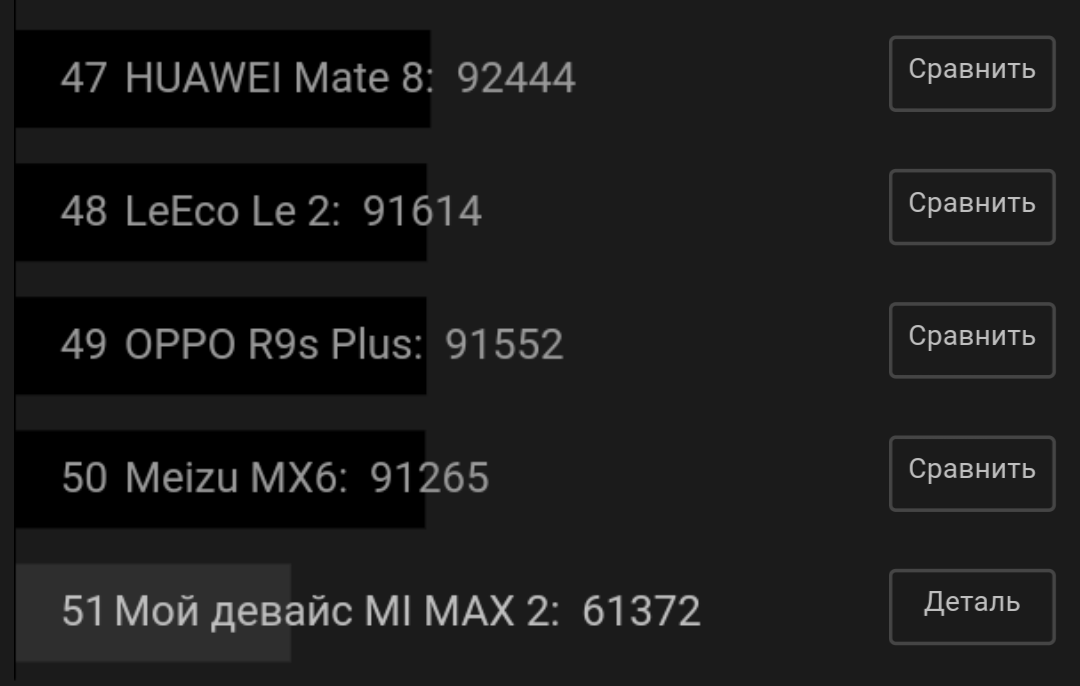

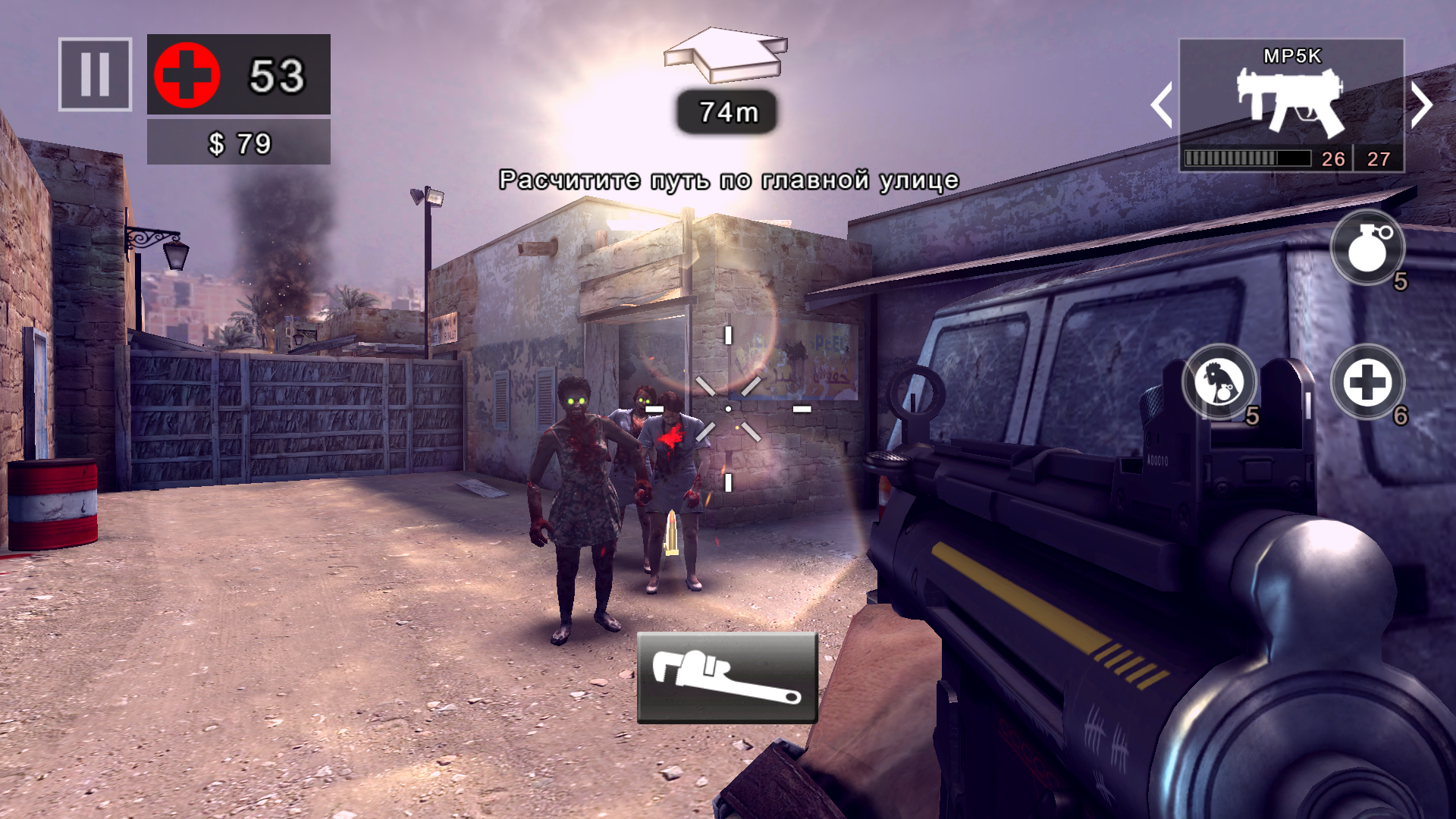
But the most important thing is not even that. After 10 minutes of furious shooting of zombies in Dead Trigger 2 at maximum settings, the smartphone barely warmed up and "sat down" in the end by only a couple of percent!
Both real and synthetic tests show excellent autonomy of the device. The gadget will not live with you without an outlet for a couple of days, only if you exhaust it around the clock with games. Thank you Xiaomi for the huge battery and economical processor combo!
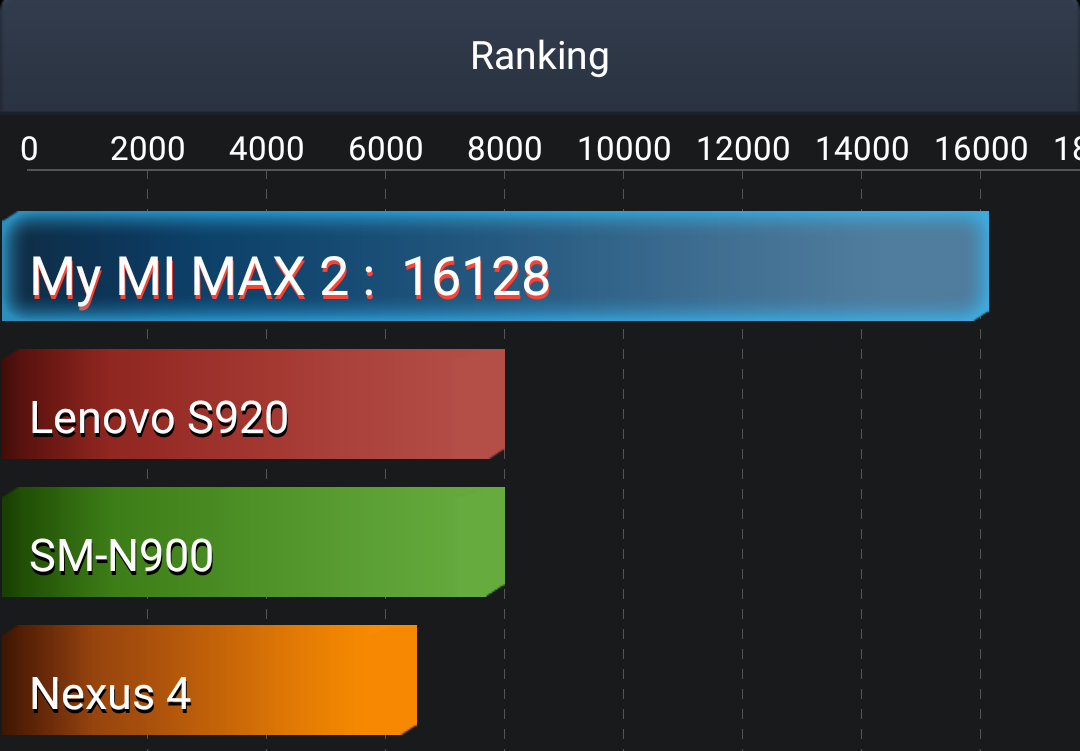
Very good camera
From the device of this price category don't expect miracles, but most users will love the Mi Max 2's camera. The 12-megapixel module does a good job even with night shots. Daytime shots, especially in good weather, come out absolutely wonderful. See examples:
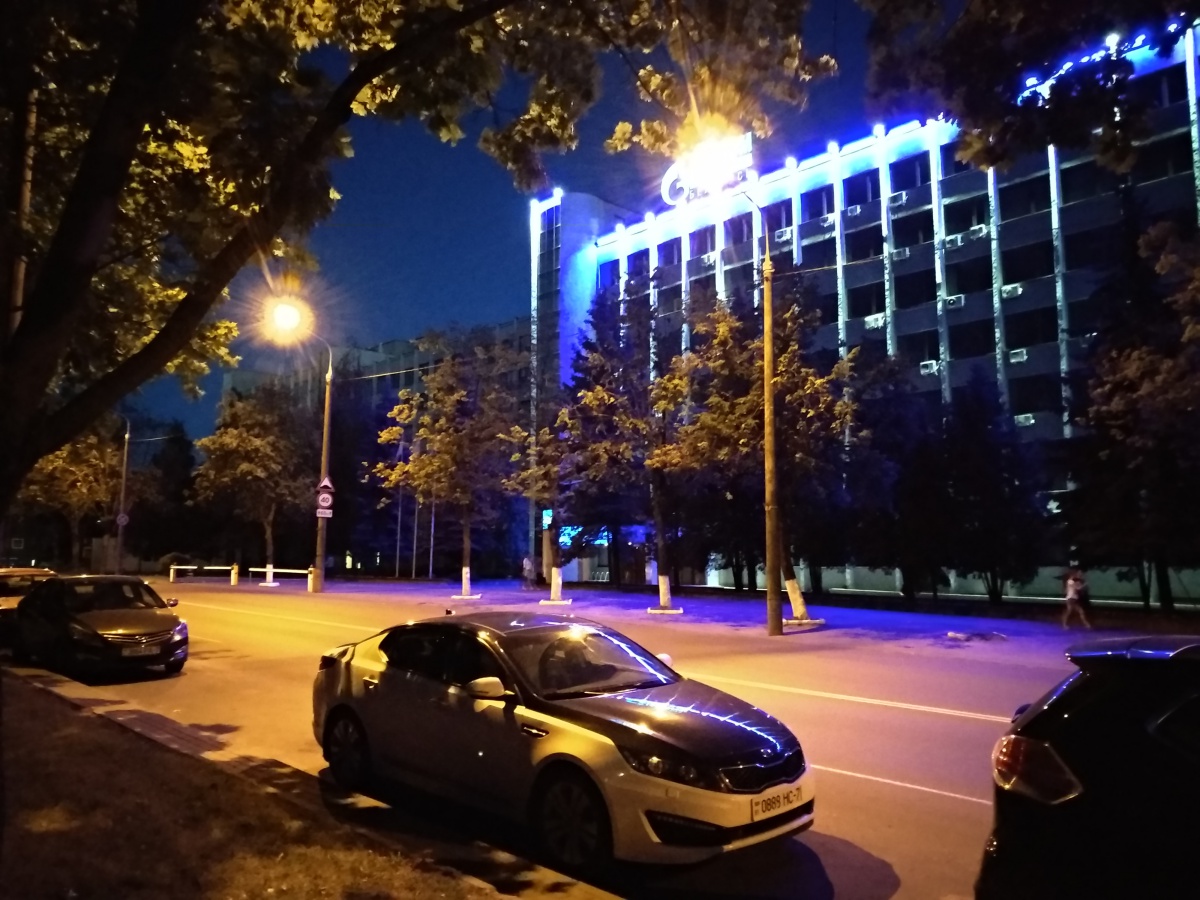

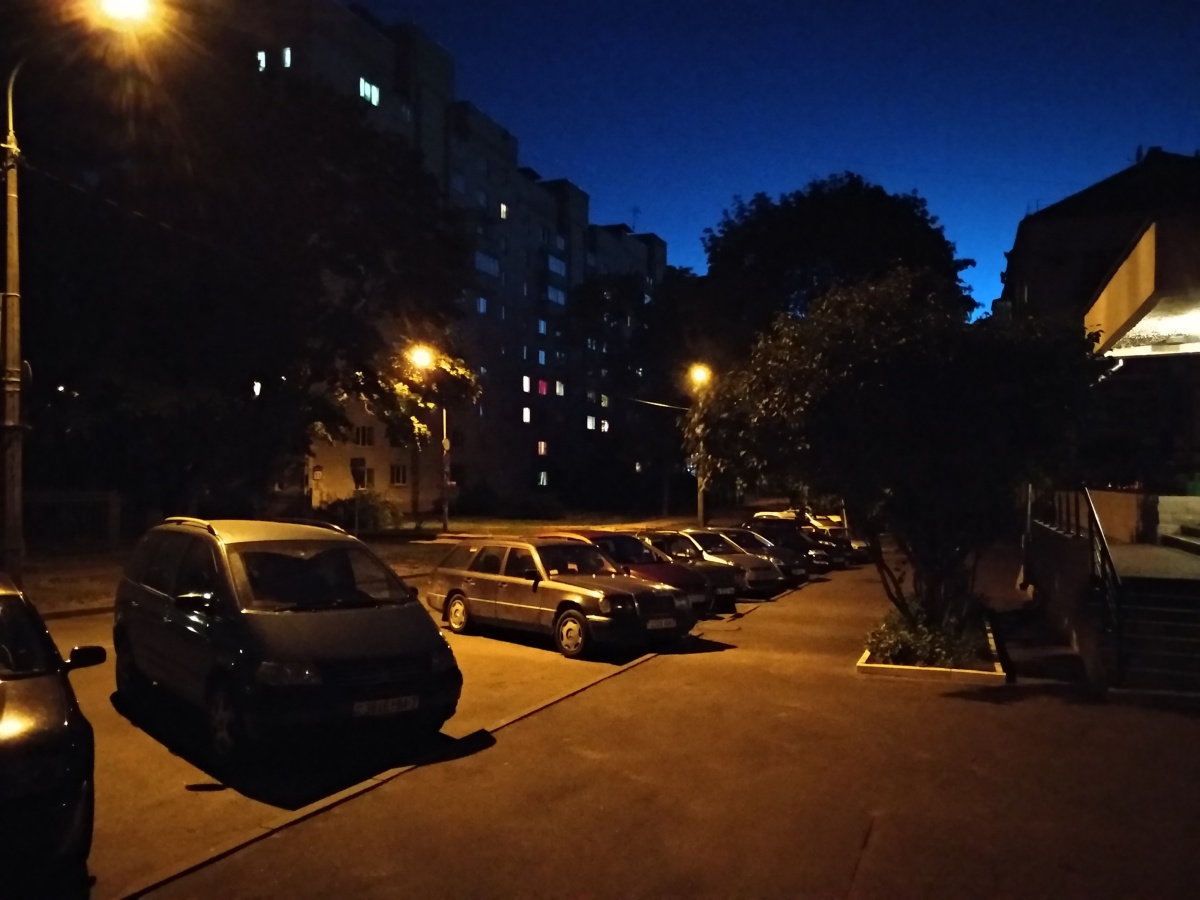





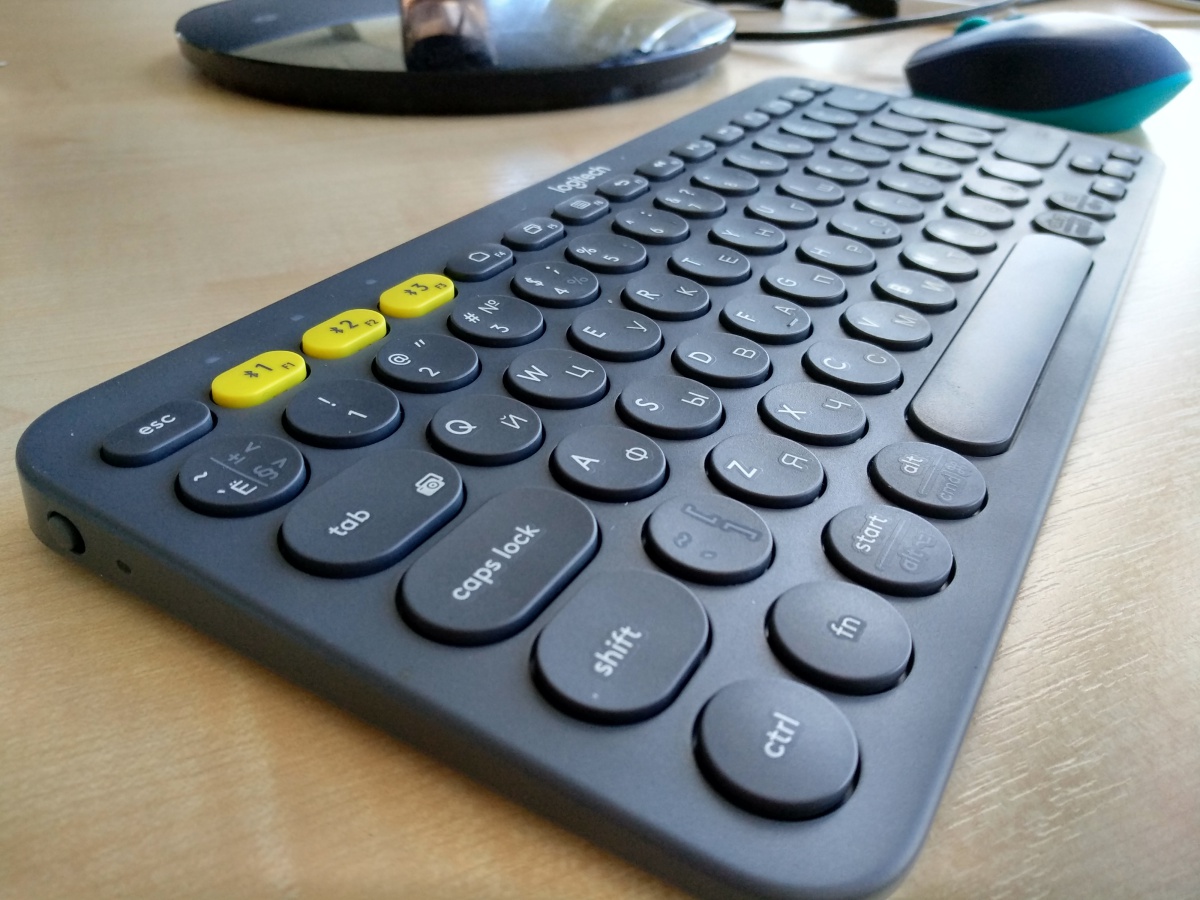



The only subjective gripe is the location of the camera, which may take some getting used to. Due to the fact that it is located in the very corner, it can be accidentally closed with your finger (after which you will have to clean it).
The front camera hasn't changed since last year. Here is the same 5-megapixel module with a fairly average image quality. Even with good artificial lighting, traces of "blurring" are visible:

It's time to go on vacation!
It seemed to us that the Xiaomi Mi Max 2 could be a great summer vacation companion.
Firstly, because of its long battery life and a large, clear display, you can watch movies or play for several hours on an airplane / train / car.
Secondly, the camera here is quite good for such devices, a large amount of memory (64/128 GB) for storing a large number of pictures and videos, as well as the ability to use two SIM-cards (local for the Internet and your own in roaming).
Thirdly, huge smartphone it can be used as a fan or a sun shade :).

Eventually
The Xiaomi Mi Max 2 is a great evolution of last year's big gadget from the Chinese manufacturer. But it should be remembered that this device, like its predecessor, is a rather niche product. Those who want a symbiosis of a large, clear display, smartphone power and tablet battery life will buy it. Those who are not embarrassed that the device needs to be used with two hands.
The advantages of Mi Max 2 include the quality of materials and assembly of the smartphone, its performance sufficient for most tasks, a good camera and an outstanding battery life. On the downside - a rather mediocre display and lack of protection against water.
As for the price of the device, it is expected in Belarus at 700 rubles.
The smartphone for testing was provided by the official importer of Xiaomi in Belarus - ELKO.BY. The company had no opportunity to influence the test result and did not see the material before publication.
The announcement of the second generation of Xiaomi phablets took place a year after the appearance of the first Mi Max. At the end of May 2017, the head of the corporation, Mr. Lei Jun, showed the public Xiaomi Mi Max 2, the characteristics of which attracted the attention of not only potential consumers, but also market analysts. mobile devices... Using the Mi Max 2 as an example, you can track the direction of smartphone development chosen by Xiaomi.
Xiaomi Mi Max 2: release date and price
The official announcement of the new phablet took place on May 25, 2017. The previous generation Mi Max was released on May 10, 2016, so we can talk about the formation of a new tradition - the May presentation of new smartphones from Xiaomi.
But the release date of Xiaomi Mi Max 2 on the market will be slightly different. On the shelves of chain stores and official sellers of smartphones of this brand, the second generation of phablets will appear no earlier than June 1. So it's too early to rush to the shops.
But fans of the brand will have time to think and raise money to buy a new smartphone. The phone is inexpensive - the price of Xiaomi Mi Max 2 in the initial configuration does not exceed 250 dollars USA. For the most pumped version, you will have to pay about $300 .
Xiaomi Mi Max 2: design
For $ 250-300, buyers of Mi Max 2 get their hands on a device with a very interesting design. The screen, symmetrically inscribed in the front part, complements completely metal case, the dimensions of which will not interfere with the use of a huge phablet with one hand.
On the back are the main camera lens, flash and fingerprint sensor window. Rear part flows into the front without clearly defined edges. The corners of the body are slightly rounded.
Only the ends at the top and bottom of the phone are clearly highlighted. At the bottom there is a charging input and perforation for speakers, which are also present at the top, forming a stereo pair. The upper end is at the mercy of the antenna, which is woven into the body with a soft and harmonious protrusion. Note USB Type-C instead of microUSB.
Xiaomi Mi Max 2: hardware specifications
Official specifications Xiaomi Mi Max 2 looks like this:
As you can see, in the second generation of phablets, Xiaomi made a choice in favor of energy efficiency, sacrificing computing power. But they did not regret the RAM and internal memory for Mi Max 2. Perhaps, 4 GB RAM will be able to compensate for some sluggishness of the processor. However, Snapdragon 625 showed not so bad results in GeekBench and AnTuTu, so Mi Max 2 owners will not have any particular difficulties with games and applications.
Nevertheless, we have to admit that the speed of work will drop a little. How strong? To answer this question, we have prepared charts with indicators in benchmarks of models from the past and 2017 release. Among them are the first Mi Max, and Redmi Note 4 on Snapdragon 625.
From the novelty, one should expect performance at the level of Redmi 4 Prime - phones built on the same 625 Dragon. The forecast is relevant in relation to the overall operating speed (Antutu, BaseMark OS 2.0), the processing power of the central processor (GeekBench) and the performance of the graphics system (GFX 3.1, BaseMark X). The results are in front of you, everyone can draw conclusions for himself.
Xiaomi Mi Max in AnTuTu 6
Mi Max in BaseMark OS 2.0
Xiaomi Mi Max in GFX 3.1 Manhattan
Mi Max in BaseMark X
Xiaomi Mi Max 2: battery
With the battery, the Mi Max 2 is more fortunate than its predecessor. The second generation of phablets received a battery for 5300 mAh... According to Xiaomi marketers, the battery capacity is enough for 18 hours of video demonstration, 9 hours of continuous play, 21 hours of the navigator, 10 days of audio broadcast.
| Xiaomi Mi Max 2 | Mi Max | |
|---|---|---|
| Battery | 5300 mAh (non-removable) | 4850 mAh (non-removable) |
| Autonomy rating | ??? | 108 hours |
| 3G calls | ??? | 24:09 |
| Internet | ??? | 19:25 |
| Video | ??? | 16:42 |
The predecessor - Mi Max - had not just order, but complete order with autonomy! A phablet with a 4850 mAh battery is still listed among phones with best time work from a single charge in all operating modes. For comparison, we again prepared diagrams in which you can compare Mi Max as with absolutely the best phones in terms of autonomy, and with the average in this indicator.
Xiaomi Mi Max: autonomy rating (in hours)
Xiaomi Mi Max: Internet time
Xiaomi Mi Max: battery life when watching videos
Thanks to the support Quick Charge 3.0 , the battery can be recharged up to 65% in just one hour. The charging mechanism itself is implemented on the basis of a double module, which guarantees uniform heat dissipation from the battery and chips.
The battery capabilities of the Mi Max 2 are not yet confirmed by reviews real consumers, but analysts have already conducted an original test comparing battery consumption after 1 hour of playing, watching videos and listening to audio.
As a result of this test, Mi Max 2 bypassed not only its predecessor, but also the flagship smartphones of rival companies - Huawei P10 Plus and iPhone 7 Plus, along with iPad 4 Mini, the battery of which is comparable in capacity to the battery of the Xiaomi phablet.
Xiaomi Mi Max 2: camera and display
The screen of Mi Max 2 has a record diagonal dimensions - 6.44 inch at display resolution 1920x1080 pixels (Full HD format). Pixel density is far from record, but acceptable - 342 ppi... The aspect ratio of the display is the classic aspect ratio of 16: 9, allowing you to watch wide-screen movies with great comfort and flip pages in the browser with little or no scaling.
The screen brightness is fixed at around 450 cd / m2, which is quite enough for a comfortable viewing in direct sunlight. The ratio of the screen area to the front side of the phone is 74.28%, but with such diagonal dimensions this figure is practically irrelevant.
The Mi Max display had one significant problem - poor readability in the sun. In this respect, the giant was inferior to almost all of its tribesmen, and was seriously inferior. The question is, have the developers managed to fix this defect? Practice shows that the company knows how to work on errors - compare at least the displays of Redmi Note 4 2016 and 2017 release. In short, in Mi Max 2 we are waiting for quality improvements and a decisive step forward in terms of screen readability!
The shots from the Mi Max camera were distinguished by good color reproduction and normal white balance, sufficient sharpness throughout the frame. HDR worked great. The disadvantages of the camera could be written about high level noise that caused detail to suffer. But the evening shooting was given to the smartphone perfectly, at least for this price segment... Most likely, in the Mi Max 2 camera, the developers will retain the strong properties of its predecessor and correct the shortcomings. 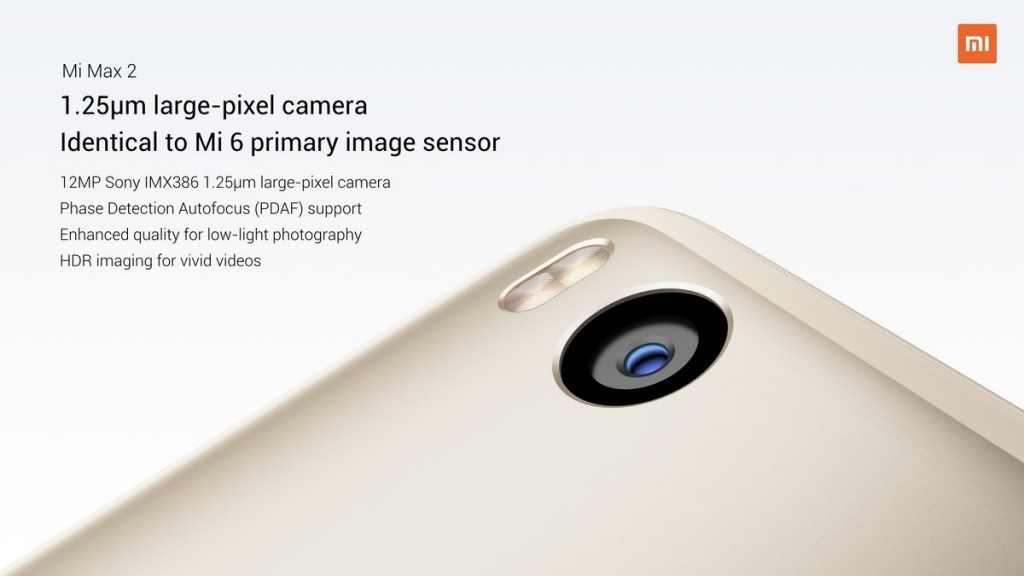
Xiaomi Mi Max 2: key points
1. Xiaomi Mi Max 2 will not have the performance of its predecessor. The 8 Cortex A53 cores of the Snapdragon 625 will never beat the Cortex A72 of the Snapdragon 650/652 chipsets.
2. The autonomy of Mi Max 2 will be even steeper than that of the first model. Energy efficient Snapdragon processor 625 and a 5300 mAh tablet battery will allow you to operate new smartphone days, without worrying about timely recharging.
3. According to the passport data, the display of Mi Max 2 does not differ from its predecessor. They have the same diagonal, similar pixel density and brightness. If according to tests, the display of Mi Max 2 is not much inferior to the flagship models of the brand, the phablet can be considered as an inexpensive competitor to premium smartphones.
4. The Mi Max 2 camera will suit even unassuming street photography enthusiasts and photographers who want to have a mobile camera at hand. In addition, the capabilities of the Sony IMX386 sensor will be complemented by native and third-party software.
Samsung autonomy Galaxy Note 8
The autonomy of the Samsung Galaxy Note 8 is perhaps one of the most pressing issues for a future buyer, given the enlarged display and the sad history of its predecessor. We offer official statistics.
Samsung Galaxy Note 8 officially presented. We offer a first look at the Note-flagship: the main advantages, differences from the Galaxy S8, as well as new smart features!
The official presentation of Meizu M6 Note took place. The main news is the Snapdragon 625 and the dual camera that takes very cool photos. See for yourself!
If you're looking for a smartphone that can be charged once a week, check out the Lenovo P2. The review contains all the characteristics and test results.
Top-end hardware, advanced cameras and not the most exorbitant price - about this and much more in a fresh review Asus ZenFone 4 Pro on Qualcomm Snapdragon 835.
Redmi Note 5A came out in two versions. Standard Edition is an extremely cheap option. High Edition is a little more expensive, but much more interesting in terms of characteristics!
Twin smartphones from Asus with a large battery and dual cameras: why are they so similar and does it make sense?
Although the design of the Xiaomi Mi Max 2 is not original, it looks attractive. Despite its impressive size, the smartphone is surprisingly comfortable in the hand, but it won't be possible to operate it with one left hand.
If we compare the new product with its predecessor, then the dimensions have hardly changed - 174.1 × 88.7 × 7.7 mm with a weight of 212 grams versus 173.1 × 88.3 × 7.5 mm with 203 grams for the Xiaomi Mi Max. The parameters are quite close to, but at the same time it is comfortable to hold the device in the palm of your hand. Trying to control such a giant with one hand is not worth it - the grip reliability is lost, the smartphone strives to fall out.
The front panel is protected by Gorilla Glass 4 tempered glass with a good oleophobic coating. Fingerprints and other dirt are subtle and easy to remove. At the top of the panel are the light sensor, earpiece and front camera. At the bottom are the touch-sensitive navigation keys. When the screen is activated, they are backlit with a dim light.
The back panel is made of metal and practically does not slip in the hand. It houses the main camera with flash and a fingerprint sensor. There are plastic inserts for antennas at the top and bottom of the panel. The edges of the back are rounded and form one piece with the side edges. On the right side of the case are the volume rocker and the power button, and on the left is a hybrid SIM and microSD slot.
On the top edge of the Mi Max 2 there is a mini-Jack connector, an additional microphone and an infrared port. The main microphone is located on the bottom edge, USB port Type-C and music speaker.
Buy Xiaomi Mi Max 2 is possible in two colors: black (Matte Black) and gold (Gold).
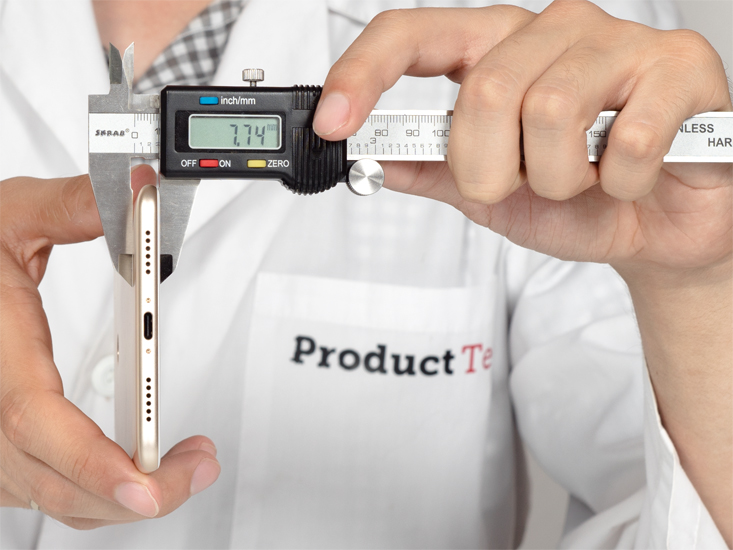
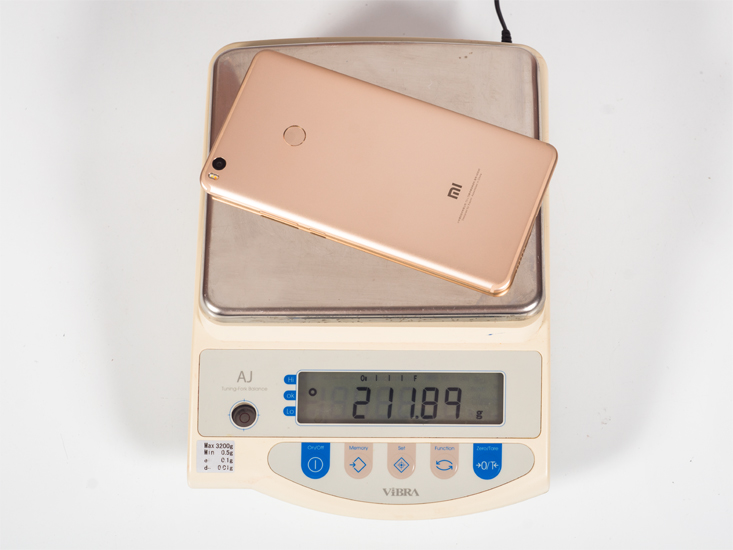
Screen - 4.5
In addition to the impressive 6.44-inch diagonal, screen Xiaomi Mi Max 2 stands out for its good color reproduction and contrast. It is very comfortable to watch the video on it.
Despite its size, the display has a "normal" resolution of 1920 × 1080 pixels. Nevertheless, their density can still be called high, with a value of 342 ppi allowing individual pixels to be distinguished only under a magnifying glass.
The brightness range we measured is 0.6 to 440 nits. This is a good result, which makes it equally comfortable to use the device both in the dark and on a sunny day. The high contrast ratio - 1600: 1 contributes to this. The screen has a color gamut of 94% sRGB or 70% AdobeRGB. The color accuracy is quite high - the average error does not exceed three units.
Three values of color tones are available in the smartphone settings - "Warm", "Neutral" and "Cold". The default is “Neutral”, but the color temperature is too high in this mode, which makes the screen slightly blue. Even more blue shades become in "Cold" mode, in "Warm" the temperature value practically corresponds to the reference one.
The viewing angles are wide. If you look at the screen from a wide angle, you will not notice a strong decrease in brightness or color distortion.
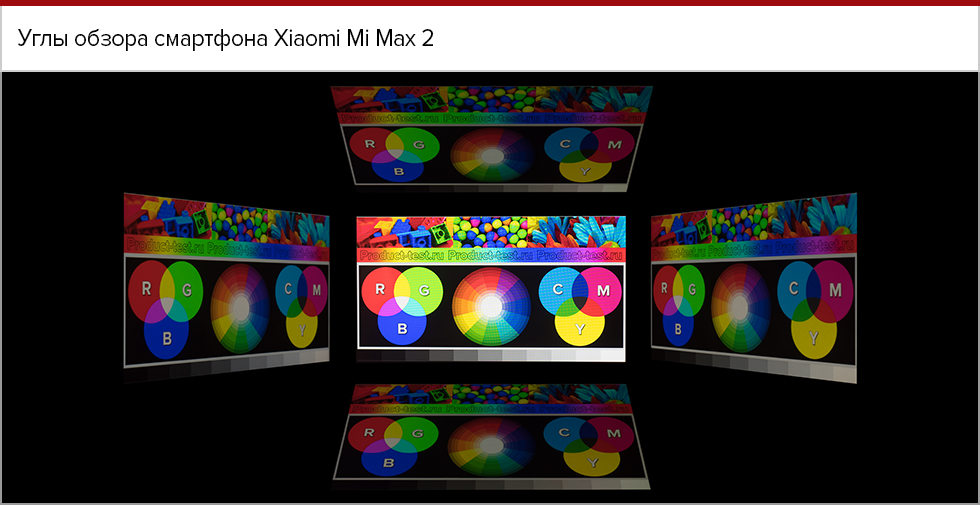
Cameras - 4.7
Xiaomi Mi Max 2 is equipped with good 12 and 5 megapixel cameras.
The main one is represented by a Sony IMX386 sensor, and its lens has an f / 2.2 aperture. Also available with LED flash and phase detection autofocus.
The camera interface is responsive, the shooting speed is high. In daylight, photos are often of high quality, with good detail, but the autofocus performance is sometimes satisfactory. For example, he may “miss” in automatic mode image, causing the picture to lose sharpness or white balance accuracy. We can only hope that the problem will be fixed with a software update. The color rendition is somewhat brighter than natural, although many will even like it. The HDR mode adds tints to pictures, improves the development of shadows, which has a positive effect on photography.
Night shooting predictably introduces color noise, and sharpness also drops. This is where flash and a special night mode come to the rescue. Its principle of operation is simple - the camera takes several pictures, analyzes them and “glues” them into one photo. This happens quite quickly, there are practically no delays in shooting. It is important to keep the device still, otherwise the sharpness will be insufficient. If you turn on HDR at night, you can get some pretty interesting shots, but they will most likely lack sharpness. 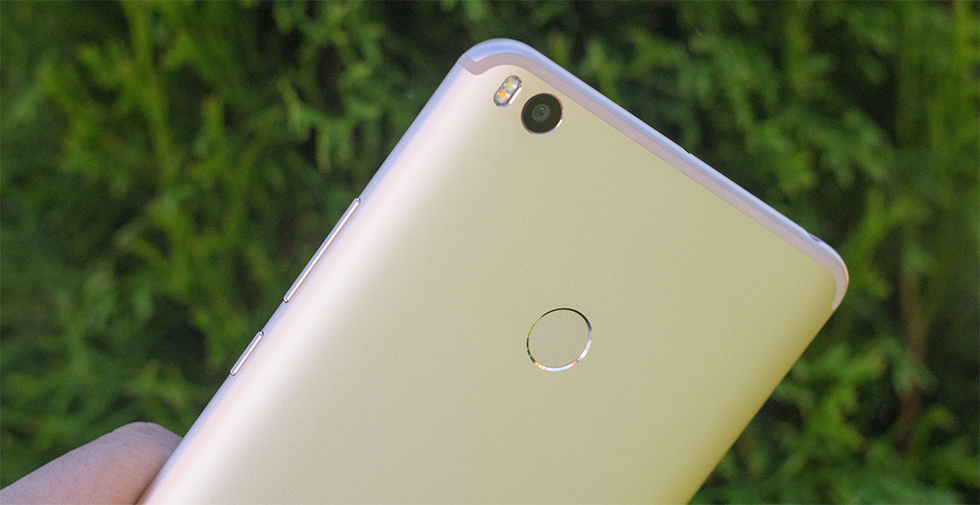
In addition, the main camera has a number of modes: "Panorama", "Timer", "Voice", "Align", "Enhance", "Group selfie", "Tilt-shift", "Square" and manual. In the latter, you can independently adjust the white balance (2000-8000), focus, ISO (100-3200) and shutter speed (up to 32 seconds).
Video recording is possible up to 4K (3840 × 2160) resolution with stereo sound. The audio bitrate is 96 kbps. The video quality is good, however, autofocus errors occur here as well. This is especially noticeable when shooting dynamic scenes. Night photography is also pretty High Quality, with an acceptable amount of noise.
The front camera has an f / 2.0 aperture. It allows you to get good photos with good level detailing. The maximum available resolution for video calls is 1920 × 1080 pixels.
Photos from the camera Xiaomi Mi Max 2 - 4.7





Xiaomi Mi Max 2, HDR photo comparison


Photo from the front camera Xiaomi Mi Max 2 - 4.7

Working with text - 3.0
Working with text on the large screen of Mi Max 2 is convenient, and the pre-installed SwiftKey keyboard also contributes to this. It supports continuous input and is equipped with dictionaries of different languages for spell checking. In addition, many settings are available. For example, you can change the keyboard theme, size, or position to make typing easier.
Internet - 4.0
Xiaomi Mi Max 2 is literally very convenient for surfing the net. Out of the box, two browsers are preinstalled - Mi Browser and Google chrome... Their functionality is similar, both support cloud sync, bookmarking, and traffic compression. However, Mi Browser has other unique features as well. For example, Reading Mode turns off the display of pictures and formats the text in a more convenient way. When night mode is activated, the contrast of the text is inverted: letters and symbols become light, and the background - dark. It is also possible to save the page for offline reading.
Communications - 3.8
The smartphone received a solid set of various interfaces and communications.
Although the dimensions of the Xiaomi Mi Max 2 make it possible not to save on connectors, there were some compromises. We are talking about a hybrid SIM card slot combined with a microSD slot. You can install microSIM + nanoSIM or microSIM + microSD. However, there are no complaints about the rest of the ports and interfaces. Both mini-Jack and FM-radio are available, and as a bonus there is an infrared port for controlling various equipment, for example,. The lack of NFC is upsetting, which makes it impossible to use Android Pay, in 2017 this can be called a drawback.
A complete list of available ports and communications is as follows:
- dual-band Wi-Fi a / b / g / n / ac with Wi-Fi Direct, Hotspot, DLNA
- Bluetooth 4.2 LE with A2DP
- GPS with A-GPS, GLONASS, Beidou
- Infrared port
- USB Type-C, USB On-The-Go
- FM radio
- gyroscope
- barometer
- accelerometer
- compass.

Multimedia - 4.4
Xiaomi Mi Max 2 does a good job with a variety of multimedia entertainment.
The built-in video player plays most video formats, "not digesting" only AC-3 and some exotic codec combinations. From the player's settings, you can adjust the brightness, volume and fit the image to fit the screen.
There are two preinstalled audio players at once: Google play Music, more suitable for online listening, and the proprietary Music player. The latter is able to conveniently sort the local music collection, search for lyrics on the web and similar compositions. True, for the full operation of this functionality, you will need an MI account. Of course, there is a graphic equalizer and sound adjustment for the type.
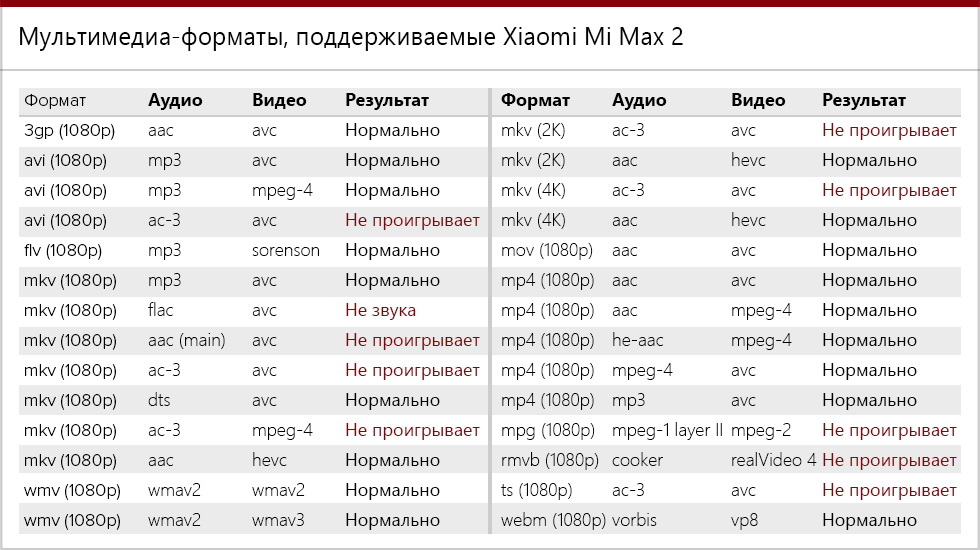
The quality of the audio section is good, without obvious failures. However, the power of the built-in amplifier is low, so it is worthwhile to approach it carefully.
The ringtone sounds loud and quite juicy. As in, two speakers are responsible for its reproduction - musical and conversational. Wherein low frequencies the music speaker plays, and the spoken speaker takes over part of the medium and high. The maximum volume of such a duo was 86 dB, which is quite loud and comparable to the work of a powerful one.
![]()
Performance - 3.7
The performance of the Xiaomi Mi Max 2 is average. It will be enough for most everyday tasks and many games, but in "heavy" graphics settings it is better not to overestimate.
Compared to Xiaomi Mi Max, the performance of the smartphone has become even slightly lower. The Mi Max 2 uses an energy-efficient eight-core Qualcomm Snapdragon 625 (Mi Max - Snapdragon 652), which has already been seen in the budget. Its computing cores operate at frequencies up to 2 GHz. The Adreno 506 accelerator is responsible for the graphics component, and 4 GB of RAM is installed.
Synthetic tests gave the following results:
- Geekbench 4 (CPU test) - 4318 points (slightly higher than y);
- Ice Storm Unlimited by 3DMark (graphics) - 13618 points (gaining twice as much);
- AnTuTu 6 (mixed test) - 62,791 points (20 thousand less than that).
During the tests in the game Injustice 2, sometimes there were slowdowns, which can be critical in a dynamic fighting game. Asphalt Extreme runs smoothly at medium settings, without noticeable lags. There is no thoughtfulness in the operation of the system interface, applications start quickly and smoothly.
Heating of the device under load is small, no more than 36 degrees in the area of the main chamber. On the rest of the smartphone's surface, the temperature does not exceed 32 degrees, which does not cause any inconvenience.
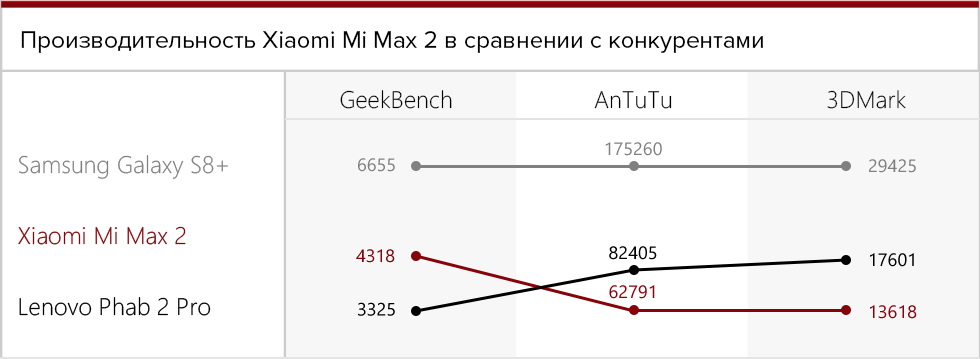
Battery - 5.0
The autonomy of Xiaomi Mi Max 2 is high. It is enough for a couple of days of active use.
The smartphone has a non-removable 5300 mAh battery. Together with an energy efficient processor, it demonstrates the following results:
- Video playback at full screen brightness - 13 hours non-stop. Reducing the brightness to a comfortable 200 nits increases this time to 16 hours.
- Listening to music in wired headphones at a comfortable volume level and with the screen off - 234 hours.
- Conversations on 3G networks - 23 hours.
The figures are impressive, very few devices can boast of a large one. Of course, with very active use, the smartphone can be discharged in a day. But if you adhere to a moderate use scenario, which includes about an hour of calls, a couple of hours of listening to music, an hour of watching videos online, chatting in instant messengers and social networks, then you will need to charge Mi Max 2 every 3-4 days.
The phone supports Qualcomm QuickCharge 3.0 fast charging. The smartphone comes with a corresponding Charger, which allows the battery to gain a charge from 5 to 100% in a little over two hours. Normal charging takes 4-5 hours.
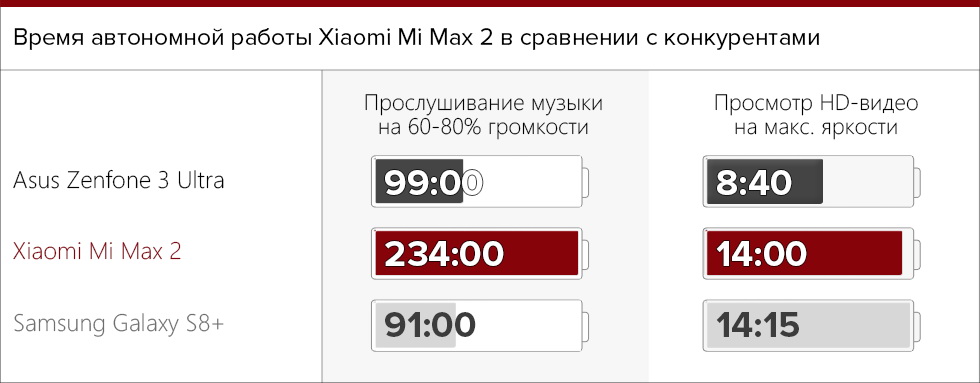
Memory - 5.0
The built-in memory of the Xiaomi Mi Max 2 is enough for any purpose. It comes in two versions:
- with 64 GB of memory
- with 128 GB of memory.
Both versions have a slot for memory cards, microSD cards up to 256 GB are supported.
We tested a phone with 64 GB of memory, of which 51.5 GB is available to the user.
Peculiarities
The smartphone is preinstalled with MIUI - a proprietary Xiaomi shell based on. It has a number of differences from the parent system. For example, there is no single application menu in this case, all icons are placed right on the desktop. There are also many settings and its own store of themes and wallpapers. All this allows you to flexibly customize the system to suit your preferences.
We also note a special mode for one-handed operation, which is very useful given the large dimensions of the smartphone. To activate it, you need to slide your finger over all the navigation keys in a row. After that, the image on the screen is reduced to the specified diagonal, and the rest is darkened. This eliminates the need to reach the other end of the device, making it much easier to operate with one hand.
The operation of the fingerprint sensor is not satisfactory - fingerprints are recognized very quickly and from any angle.
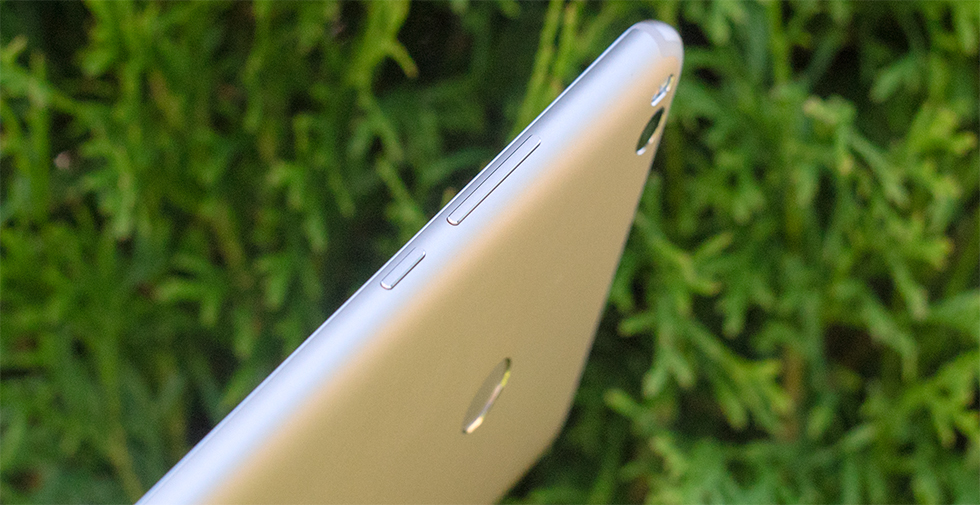
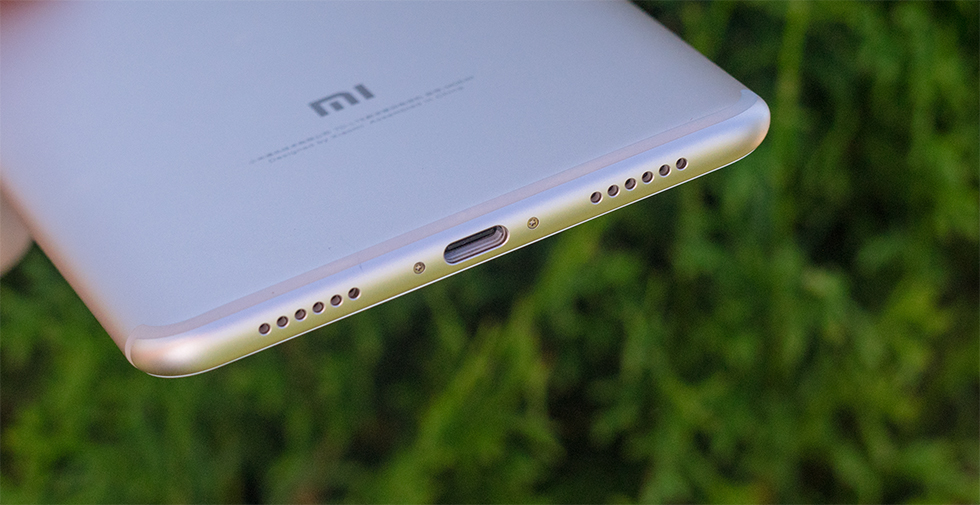
Last year, Xiaomi unexpectedly rolled out the Mi Max tablet, which users really fell in love with, despite its simply gigantic dimensions due to the use of a 6.44-inch screen. He won the hearts of buyers thanks to the excellent combination of price and productive filling. It was reasonable to expect that the second generation of the phablet will surpass the first in characteristics. But it turned out not quite like that. Yes, Xiaomi Mi Max 2 has got some very important improvements, but, surprisingly, it is based on a weaker hardware platform. The model turned out to be controversial, but no less interesting. Let's take a closer look at this new product.
Packaging and equipment
The gadget comes in a white cardboard box, which is simple in design. On its surface, only the company logo and key technical specifications devices. Together with Xiaomi Mi Max 2, we put such a modest set in the package:
- charger for 5V / 3A, 9V / 2A, 12V / 1.5A;
- USB-C cable;
- SIM tray opening needle;
- paper.
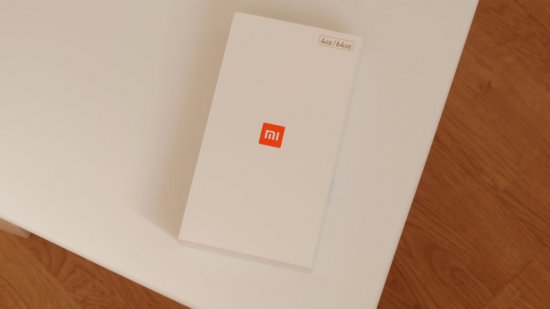
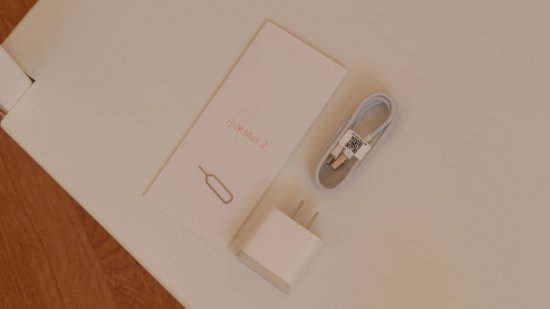
Appearance and materials of Mi Max 2
The Chinese "giant" is dressed in a solid metal case. Unlike last year's Mi Max, the freshly baked phablet does not have ugly plastic inserts on the back. For the output of the antennas, thin seams are now used, but not simple, but gracefully curved. Thanks to this decision of the designers, the device began to look more beautiful. The ergonomic properties have also improved since back cover endowed with smooth rounded edges. The Mi Max 2 is more pleasant to hold in the hand than its predecessor. The tactile feel of the body material is also better. The smartphone is comfortable to use with two hands, in which case there is no inconvenience. It is available to customers only in a golden color, where the front is white. The product weighs 211 grams and measures 174 x 88.7 x 7.6 mm.
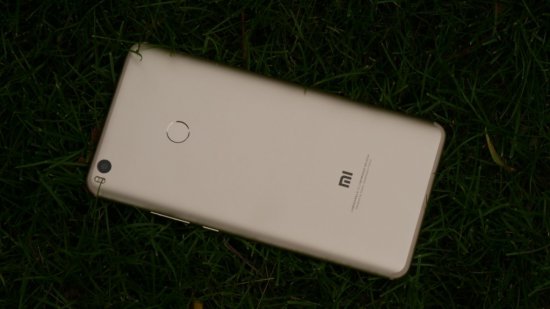
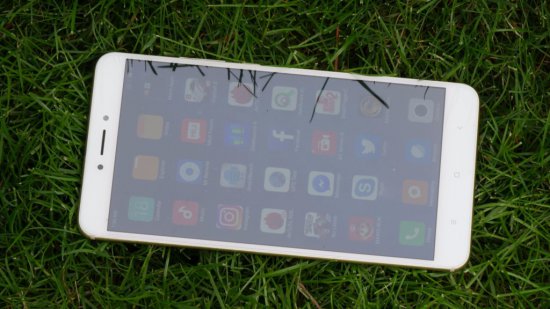
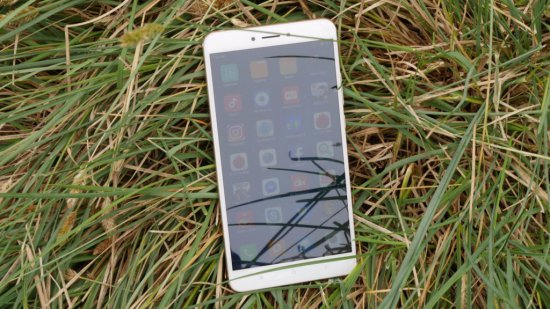
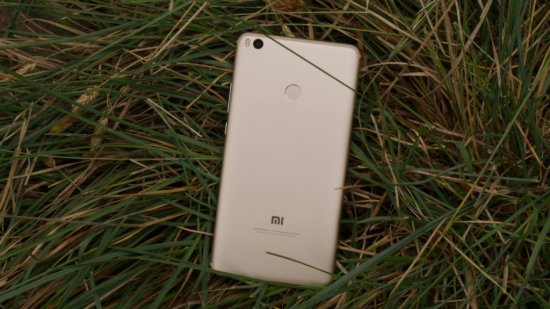
The entire front surface is occupied by scratch-resistant glass with a 2.5D rounding, Gorilla Glass 4 technology is declared. As usual, there are three touch-sensitive soft buttons under the screen, they are backlit. The upper part of the "front" is given over to the power of the ear speaker, the window of the selfie camera, sensors and an LED signaling missed messages. Inscribed on the back plane is a circle of the fingerprint identifier, which is higher than we would like. In the left upper corner the camera lens is visible, and next to it there is a two-color LED-backlight. The bottom edge carries a multimedia speaker and microphone, while the top one carries an infrared port, a 3.5mm jack and a noise suppressor hole. The controls for turning on / off and adjusting the volume are placed on the left side, while the nanoSIM + microSIM hybrid tray is on the right.
Display
The device can become a full-fledged replacement for a small tablet, since the screen here is far from small. It is very large - 6.44 inches, as in the previous model. At first glance, the quality of the screen remains unchanged. All the same IPS-matrix showing us Full resolution HD with a pixel density of 342 ppi. If you look closely, you can see both positive and negative aspects. The black stripe around the perimeter of the screen has become 53 percent thinner, it is no longer annoying. But you can complain about the viewing angles, with a strong tilt, an inversion of colors is observed. A white shade, for example, turns from normal to yellowish. But you can put up with this, regular user it will not even notice. There is an eye protection mode, as well as interactive color temperature adjustment. Brightness and contrast are good.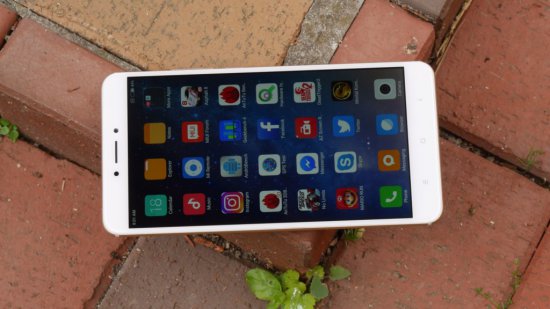
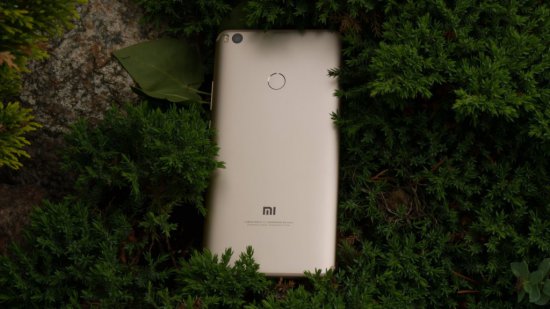
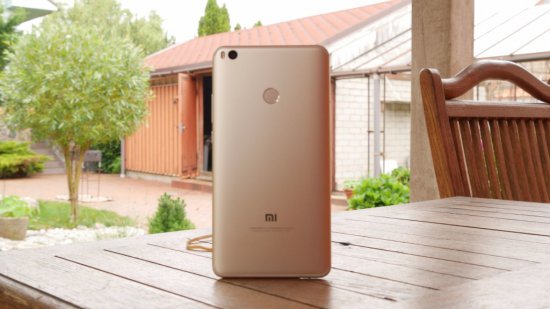
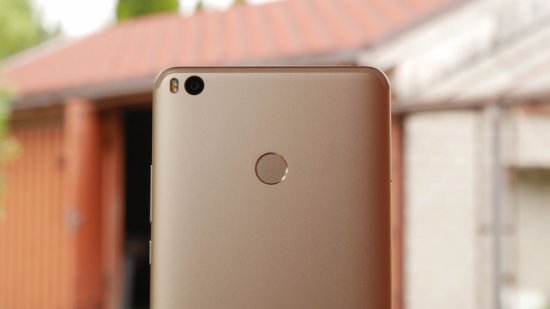
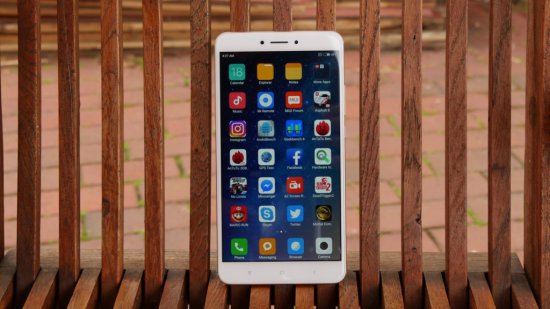
Specifications Xiaomi Mi Max 2
The operation of the tablet depends on. All 8 Cortex-A53 cores in it operate at a frequency of 2 GHz. The graphics component is handled by the Adreno 506 module. This is not exactly the filling that was expected. Many hoped to see a new generation Snapdragon 660 chipset in the Mi Max 2, but reality has dashed those hopes. The newcomer is 25 percent behind its predecessor in power, and that's a lot. But the 625th has one significant advantage - it is better in terms of energy efficiency, you can't take that away from it. Two modifications of the device have been proposed, they differ only in the amount of flash storage. You can choose a version with both 128 and 64 GB of memory. The RAM is the same - 4 GB.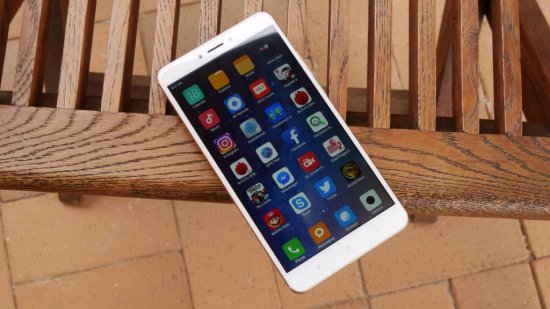
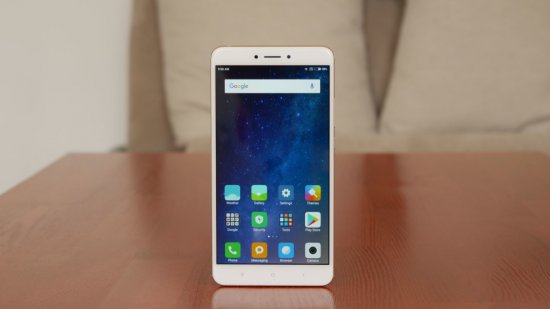
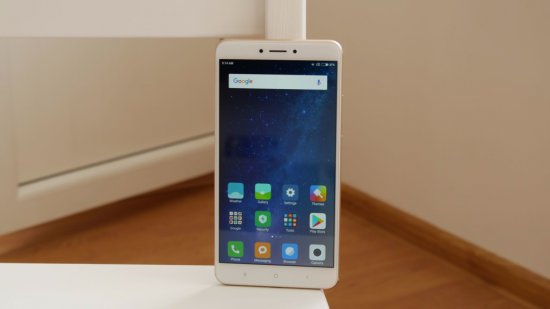
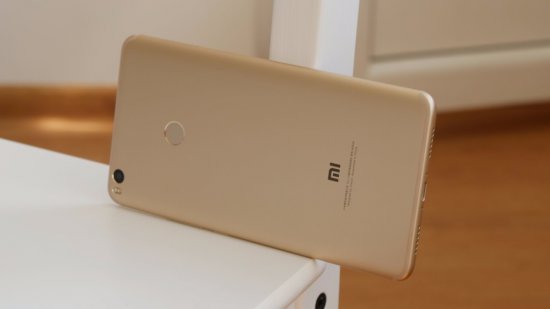
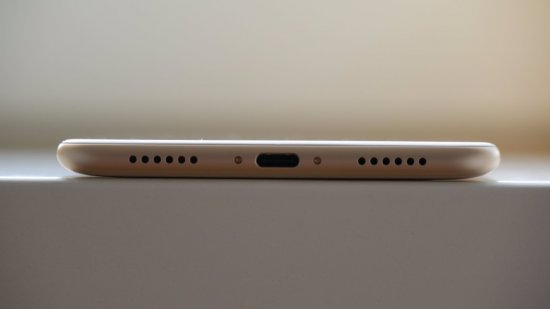
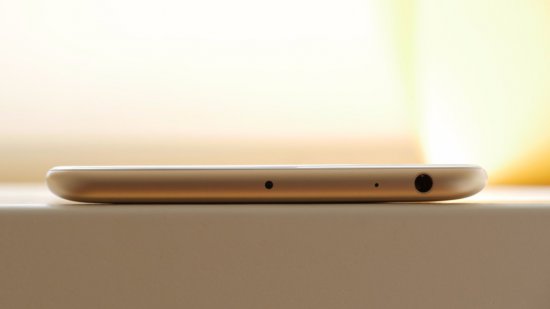
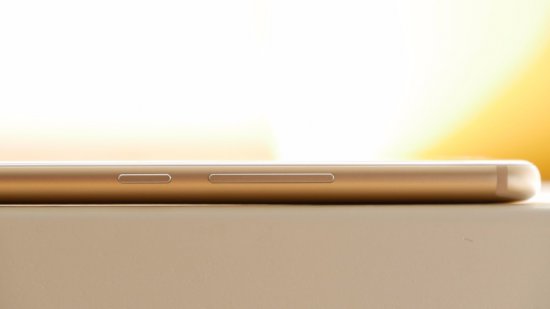
Performance and benchmarks
The processor is not the most powerful here, but it provides comfortable work in tasks that are not too demanding on resources. However, gamers should not be upset, Xiaomi Mi Max 2 is difficult to call a weakling. He can also handle heavy games, only the graphics settings need to be slightly reduced. The accelerator is, after all, as important as the central processor. The result in AnTuTu is 62,765 points. In Geekbench, the smartphone scores 859 points in the single-core test and 4190 in the multi-core test.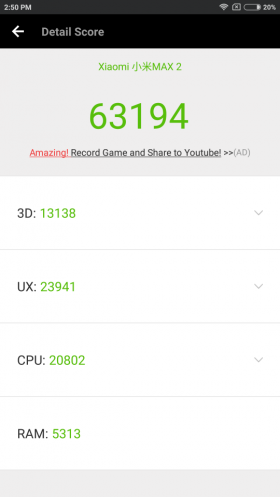
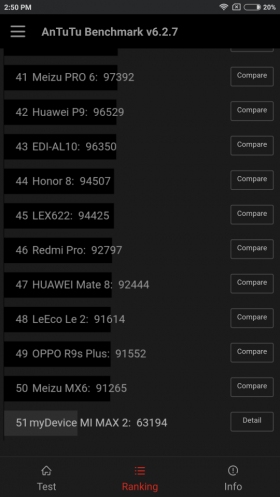
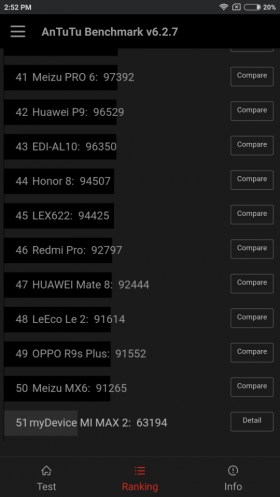
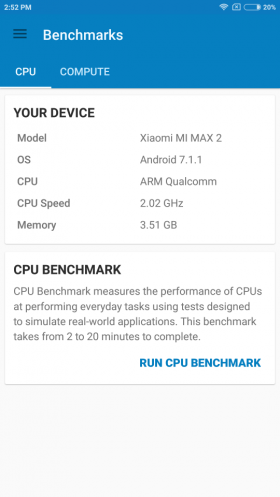
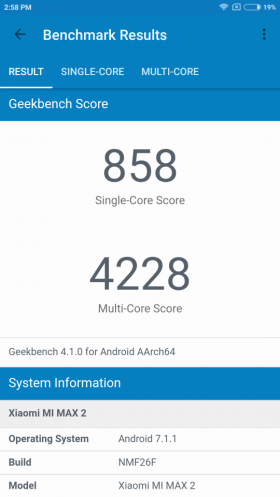
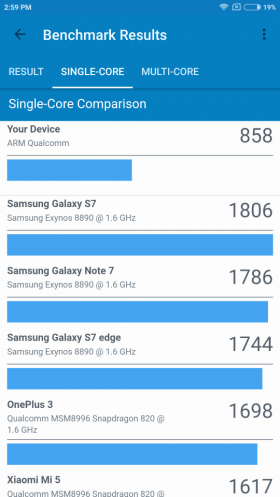
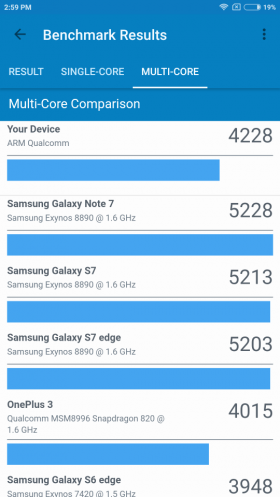
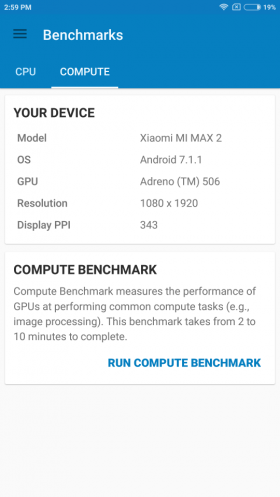
Communication, sound and sensors
The phablet is armed with communication tools such as Bluetooth 4.2, Wi-Fi dual-band, GPS and GLONASS. As a navigator, he fulfills his task perfectly. There is an NFC module for making payments, as well as an IR emitter. Supports 4G frequencies that are available in our country. When talking with the interlocutor, no problems were found, the voice is transmitted correctly. Worth mentioning availability OTG functions, thanks to this, you can not only use external drives, but also charge other devices. There is a gyroscope, a finger scanner, a magnetometer and an accelerometer.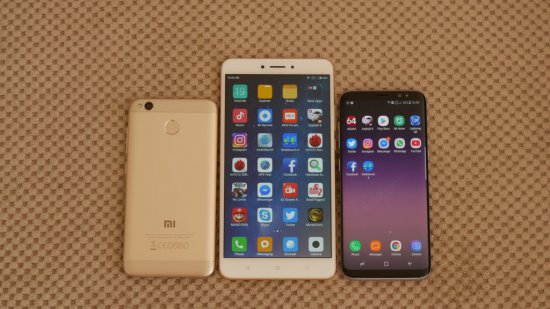
The manufacturer promised stereo sound. There is a certain volumetric effect, but this is not quite the case. In conjunction with the main speaker, the spoken speaker works. If there are no complaints about the first, then the second disappoints with distortions at maximum volume. But the volume is more than enough here, you will definitely not miss an incoming call.
Autonomy Mi Max 2
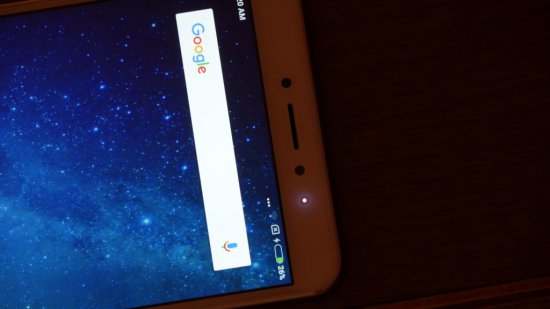
The trump card of the model is the battery with 5300 mAh. In this regard, the Mi Max 2 is superior to its predecessor. You can hope for two days of intensive use, the more "iron" energy is spent sparingly. If you watch a video at half brightness without stopping, the battery lasts 16 hours. It also lasts about 7 hours in gaming mode. Despite the impressive battery capacity, it charges in just 2 hours and 30 minutes. This is facilitated by the Quick Charge 3.0 technology, which is responsible for fast charging.
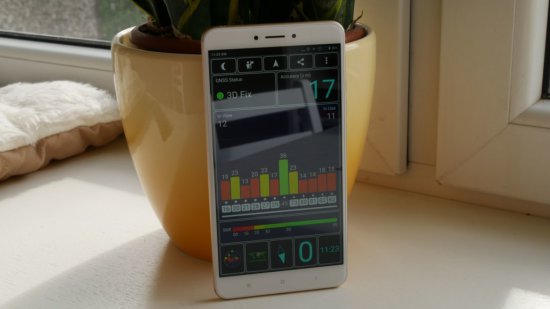
Interface and cameras
Nothing special about Xiaomi Mi Max 2 in terms of software does not stand out, although some interesting "chips" could be added to such a very large display. While the MIUI 8.2 add-on meets the user, Android 7.1.1 Nougat is completely hidden under it. An update to MIUI 9 is expected in the future, where the functionality will expand. For example, they promise a split screen mode, which this smartphone really needs. It only remains to wait.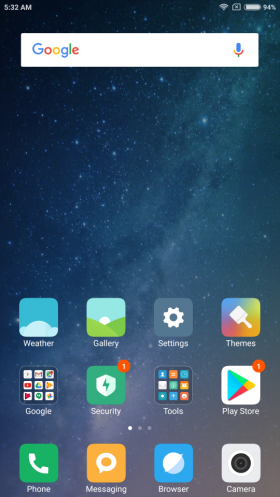
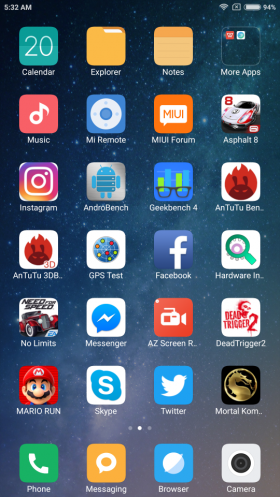
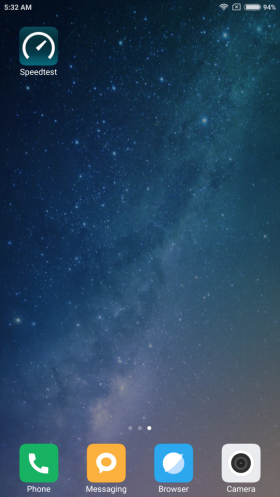
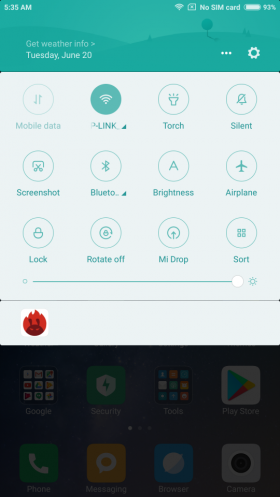
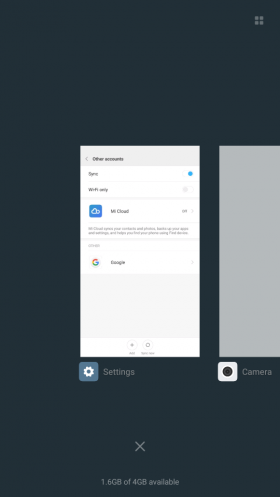
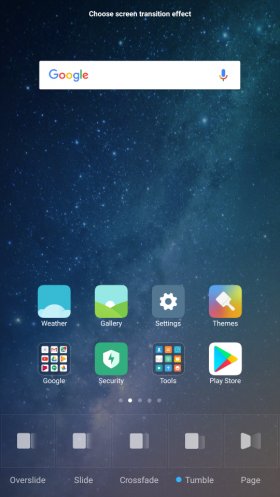




The novelty pleasantly surprised not only with its autonomy, but also with the installed main 12-megapixel camera. Thanks to the Sony IMX386 sensor, which, by the way, is equipped with and flagship Xiaomi Mi6, the device is capable of taking great pictures. The module is endowed with f / 2.2 aperture. Supplemented with phase detection autofocus and image enhancement system in low light conditions. Since there are lenses of inferior quality, the result is slightly worse than in the Mi6. The frames come out a little darker. But all the same, the hero of our review leaves a positive impression on the photographic part, especially when good lighting... At the front is a 5-megapixel camera with f / 2.0 aperture. It is inferior to the main one, since it gives out mediocre detail.
Output
Pros of Xiaomi Mi Max 2:
- good build;
- excellent autonomy;
- affordable price;
- high-quality main camera;
- current OS version.
Cons Xiaomi Mi Max 2:
- poor quality stereo sound;
- viewing angles of the screen;
- no dark color option;
- decreased performance.
At first glance at the 6.44-inch Mi Max 2, the smartphone can be confused with a small tablet. This is the largest phablet on the market that all fans of the first version of the giant have been waiting for. Was the continuation successful? Find out from our Xiaomi Mi Max 2 review.
Price and main characteristics
A smartphone with 64 GB of internal memory will cost $ 245, the cost of the older version with 128 GB is $ 300.
Specifications:
Display: 6.44 ", IPS FHD 1920 * 1080 px (342 ppi);
processor: Snapdragon 625 (2 GHz) + video accelerator Adreno 506;
RAM: 4 GB;
internal memory: 64/128 GB + micro SDXC flash cards up to 256 GB;
camera: main - 12 MP, front - 5 MP;
communication: Wi-Fi, DLNA, Bluetooth 4.2, GPS, A-GPS, GLONASS, LTE;
battery: 5300 mAh.
Dimensions: 174.1 x 88.7 x 7.6 mm;
Weight: 211 g.
A distinctive feature of the second model in the Max lineup is the presence of two stereo speakers on the front panel. The smartphone also received the seventh Android version Nougat under the brand name shell MIUI 8.
Completion and appearance
The design of the Mi Max 2 box has hardly changed compared to its predecessor. She gained a little in size and weight, otherwise everything remained in place. It's still traditional Xiaomi-style packaging with a minimal design. In addition to the phablet itself, there is a charging unit inside, a USB Type-C cable, a proprietary clip for unlocking the SIM card tray and documentation. The contents are hidden under a cardboard partition on which the Mi Max 2 is located in a recess.
![]()
The body of the device is completely metal, its back panel got rid of ugly plastic inserts. The borders of the panel have become more rounded, which fits nicely in the palm of your hand. Despite its large size, it is quite possible to manage the smartphone even on the go.
![]()
The main differences appearance new items from Mi Max are hidden in the details. Xiaomi has swapped several functional elements and used USB Type-C instead of microUSB connector.
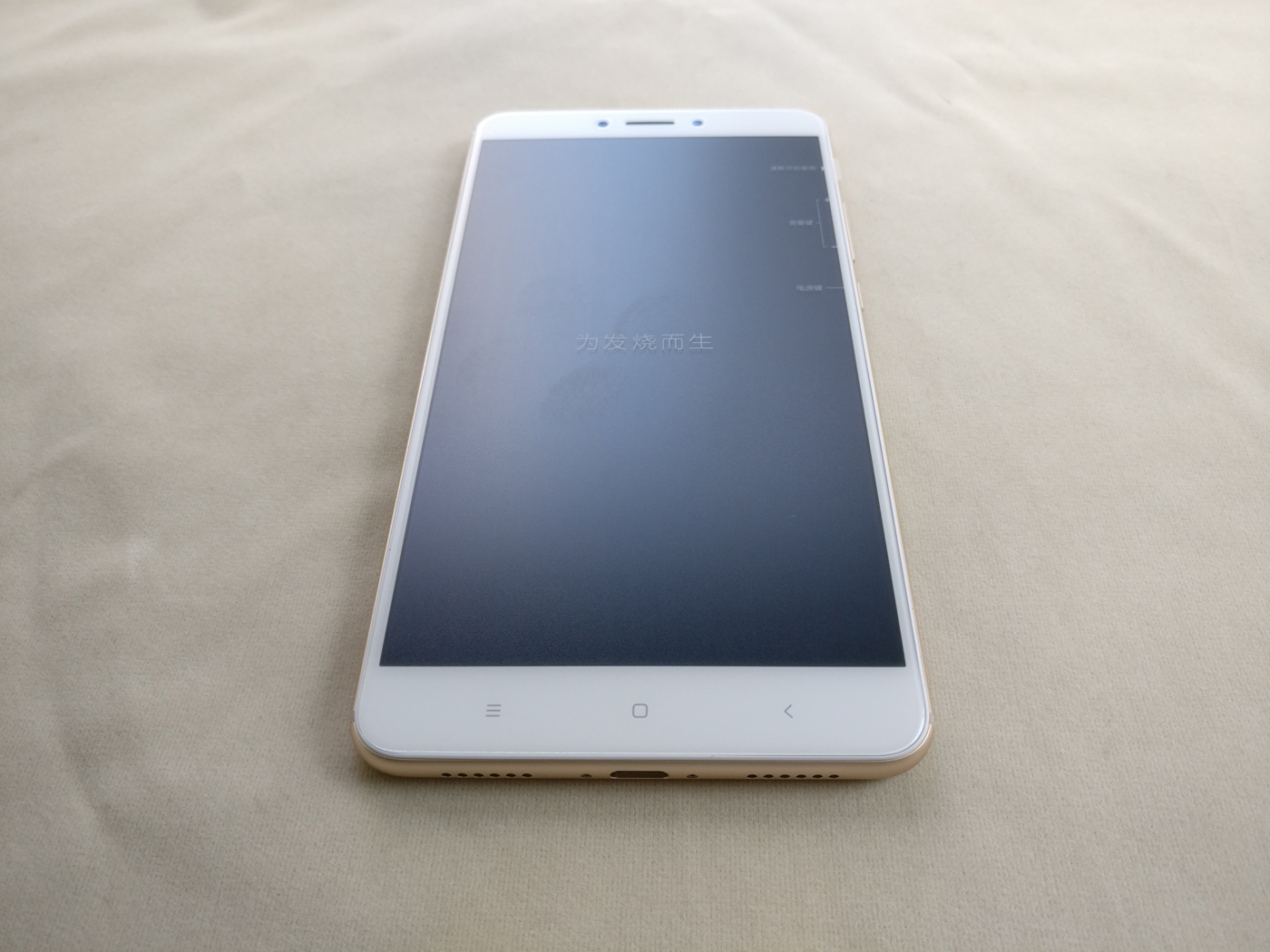
The second model in the line is also slightly thinner. The usual backlit touch keys are located under the display of the device.
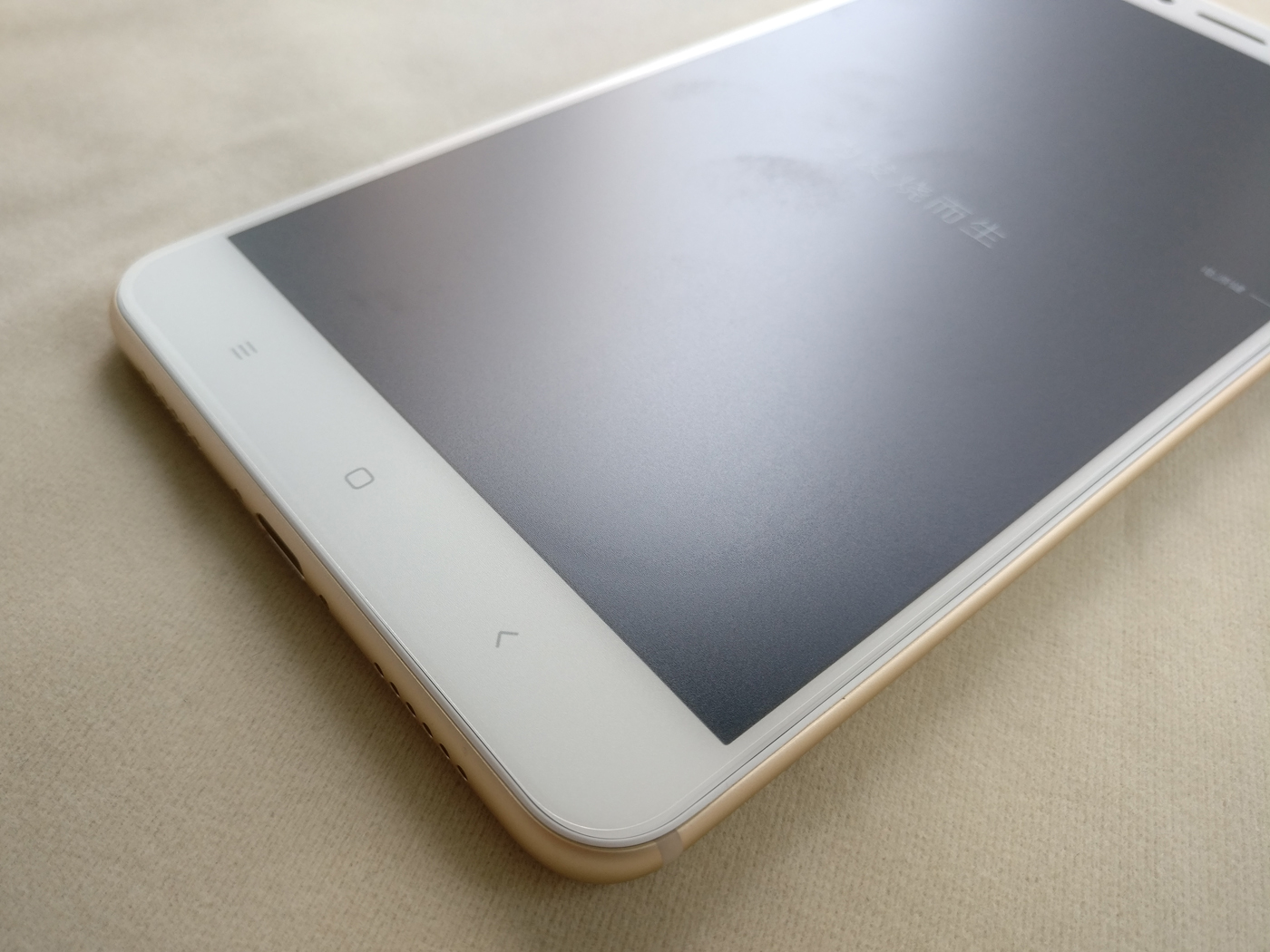
At the top of the front panel is the earpiece, symmetrically surrounded by a 5-megapixel front camera and a proximity / lighting sensor.
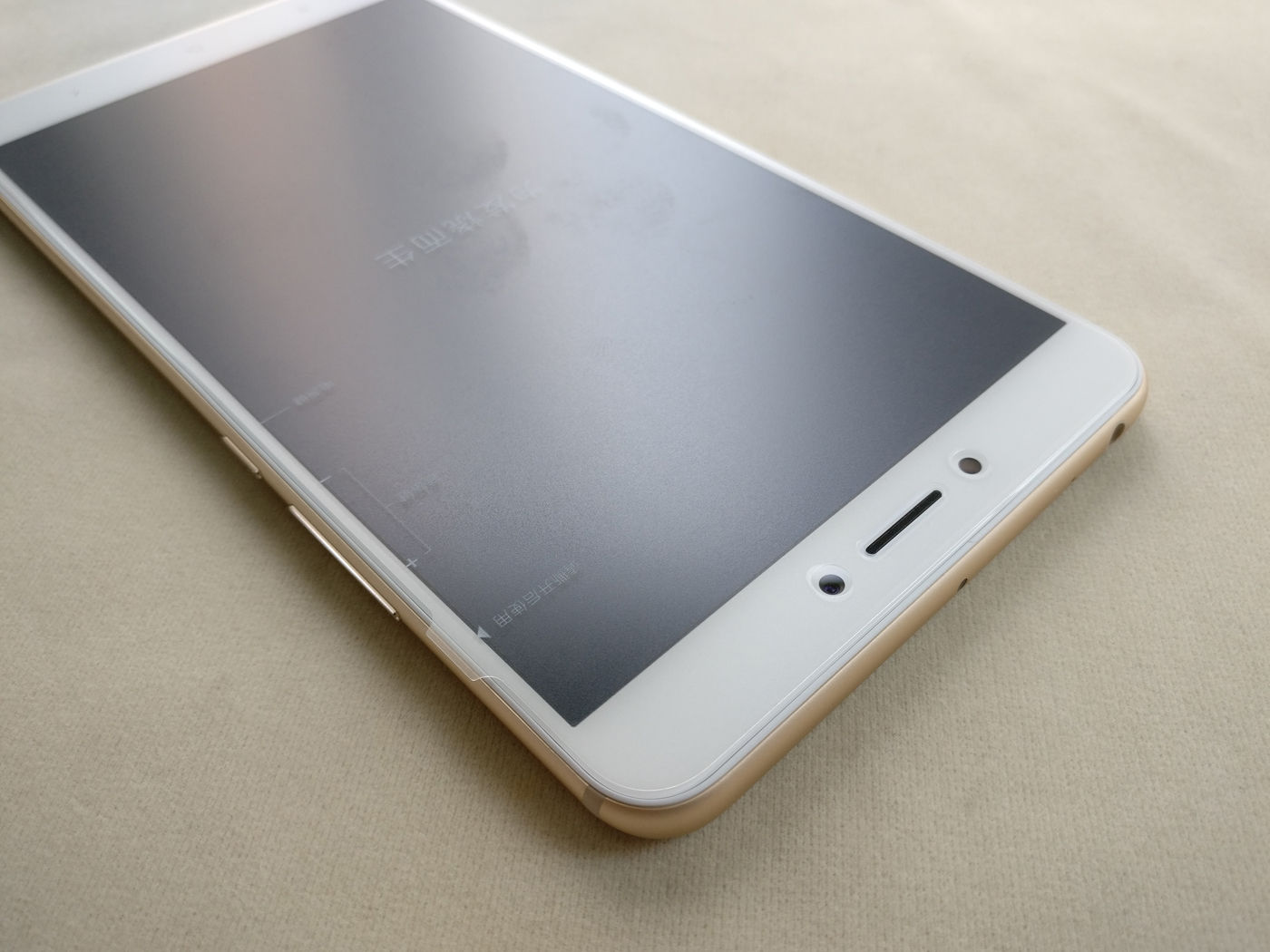
The volume rocker is located above the power button on the right side of the device. The keys have become a little more rounded, it is noticeably more pleasant to press than on the Mi Max.
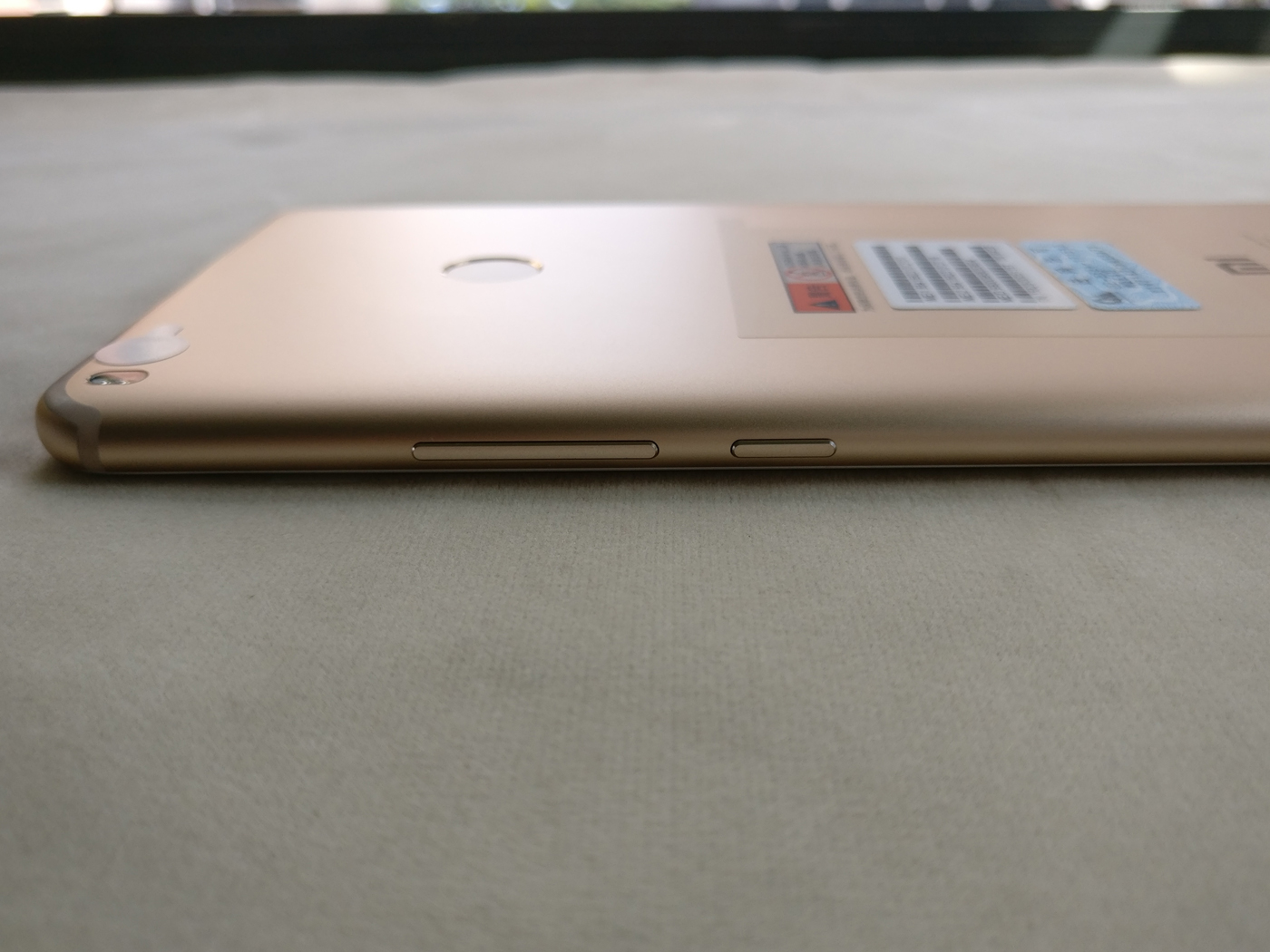
The location of the SIM card tray has not changed, it can still be found on the left. The place of one of the SIM cards can be taken by a memory card with a capacity of up to 256 GB.
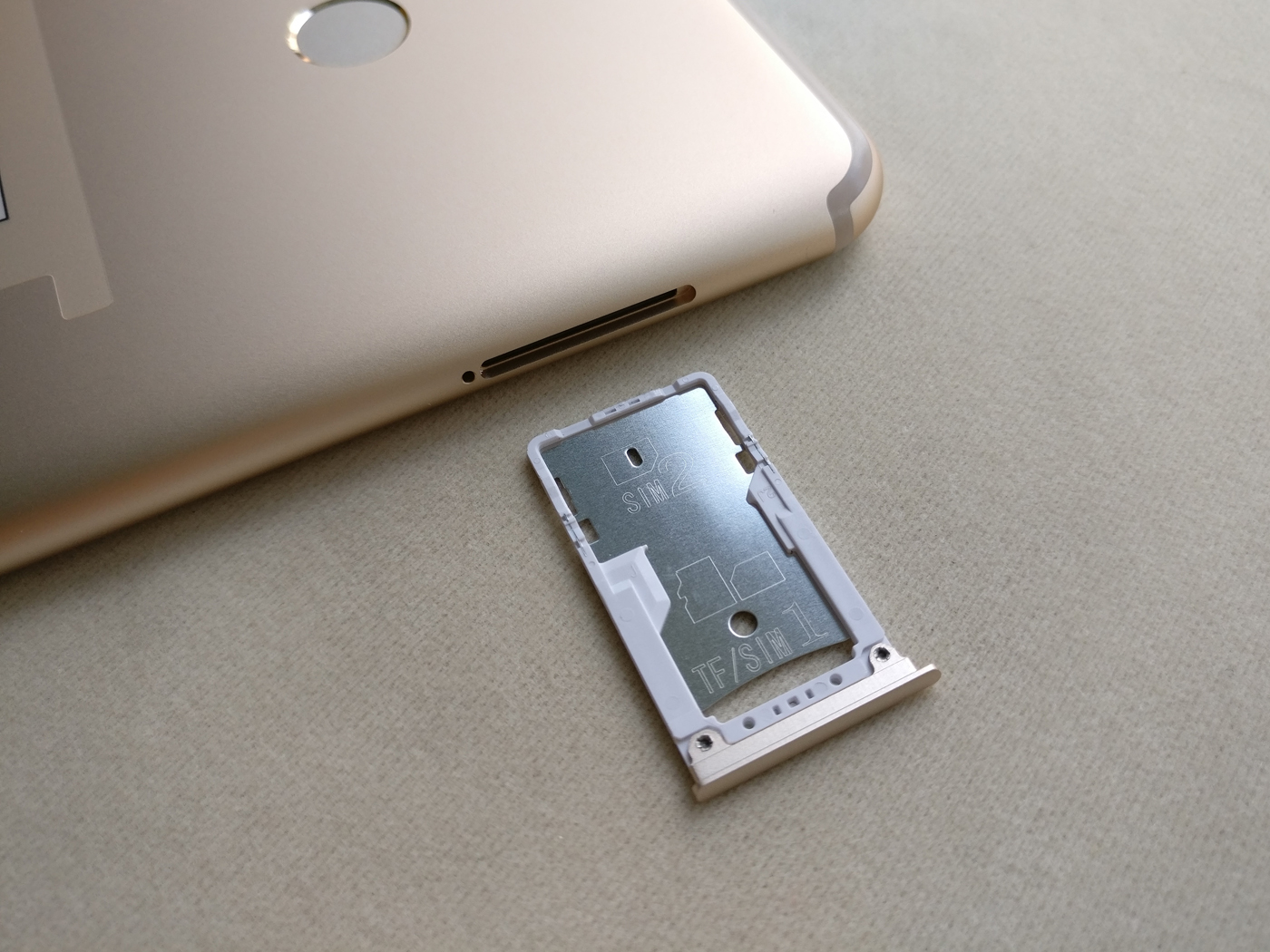
The noise canceling microphone, infrared port and 3.5mm audio input are located on the top of the Mi Max 2.
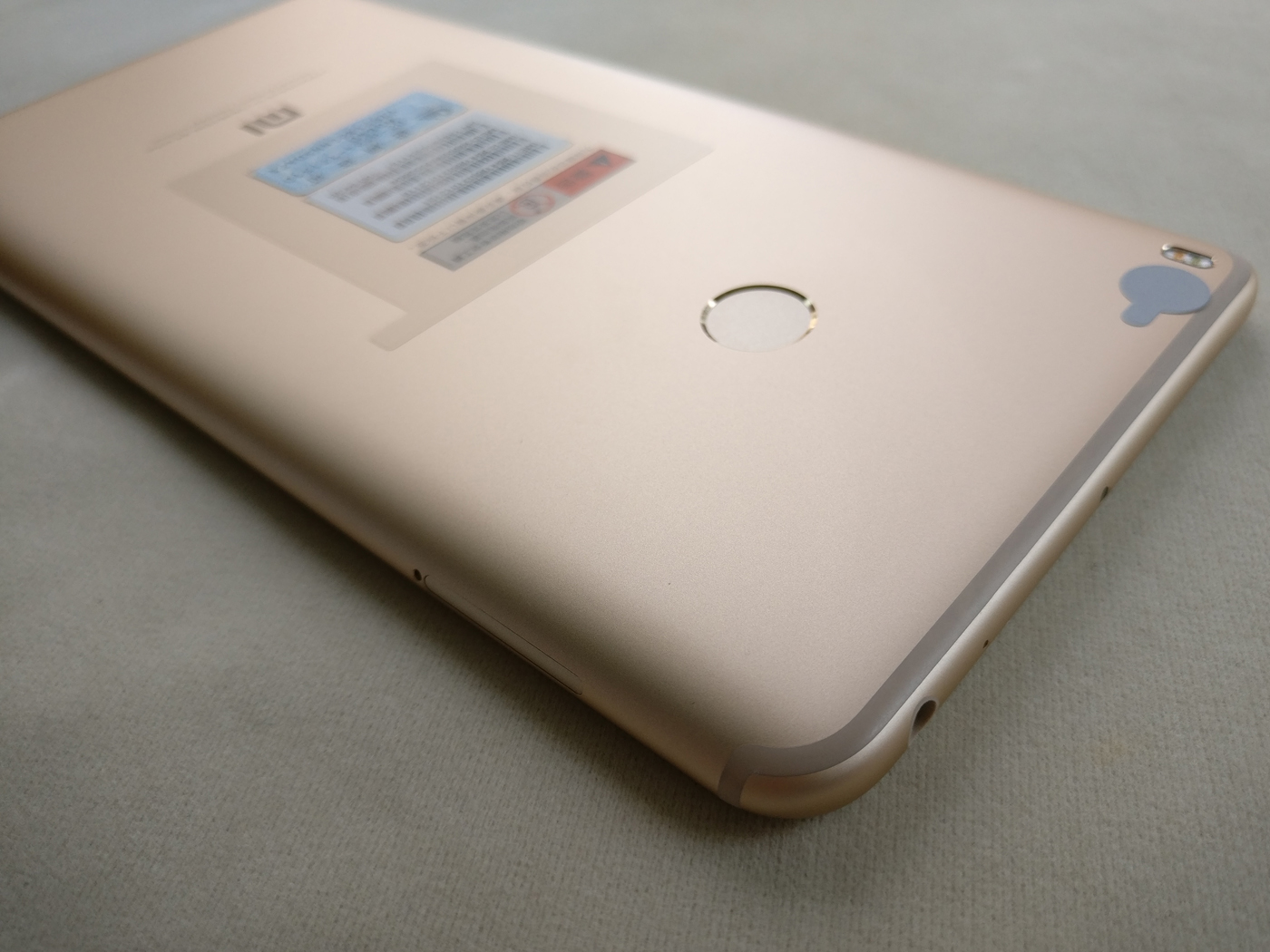
The microUSB standard is already slowly becoming history, so it was replaced with Type-C in the smartphone. Two mounting bolts and two perforations are visible on the sides of the connector. A multimedia speaker is hidden under one of them, a microphone is under the second.
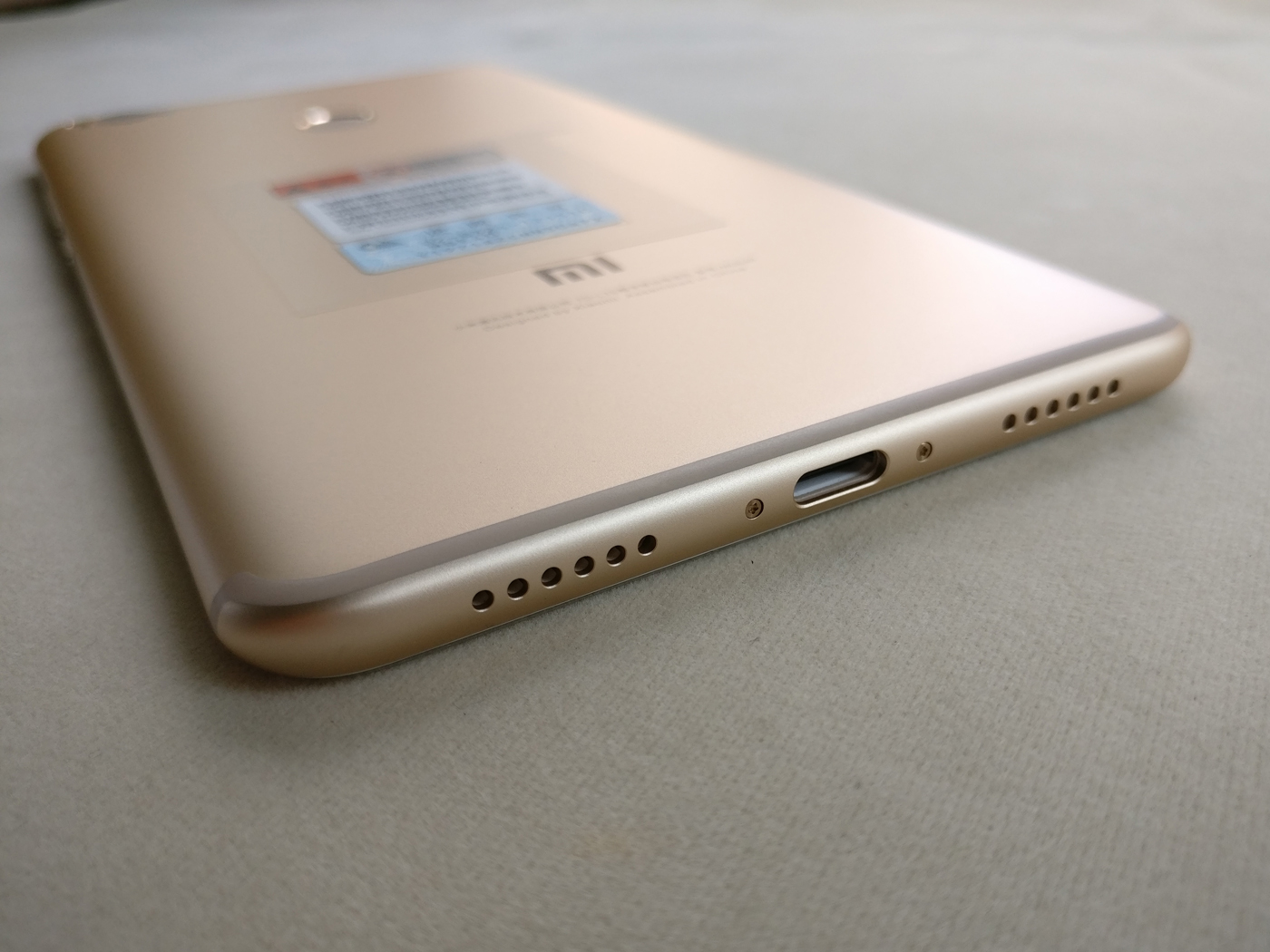
On the back is a 12-megapixel camera module with flash and a fingerprint scanner. The latter did not change its position, but the lens and flash changed places.
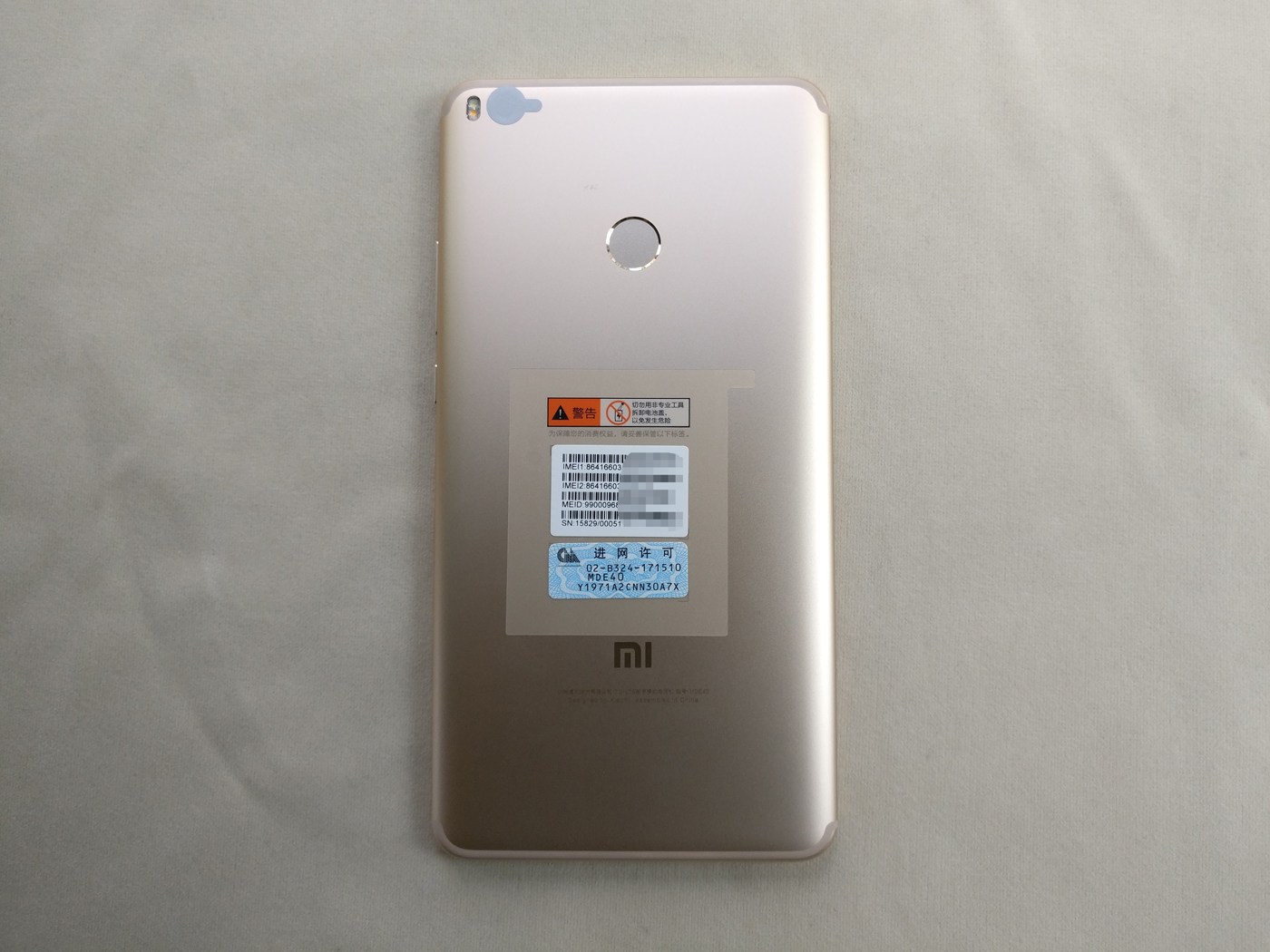
In the case of Mi Max 2, reproaches towards the size of the display are inappropriate, Xiaomi has managed to work out the ergonomics of the smartphone as well as possible. It came out nice to the touch, more robust than its predecessor, and comfortable enough for all phablet aficionados. The novelty has every chance to replace a pair of phone + tablet.
Screen
In the mobile technology market, the concept of "golden mean" is changing every year. If earlier 4.7-inch screens were perceived as the maximum possible for comfortable operation, now you will not surprise anyone with a device with a diagonal of more than six inches.
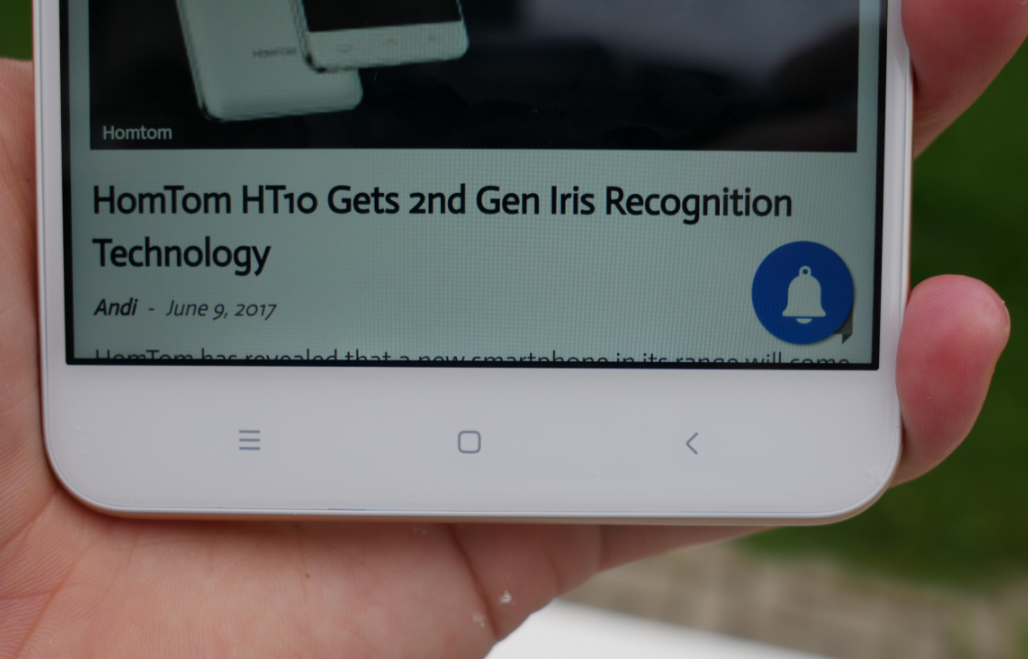
The display of the Mi Max 2 has not received significant improvements a year after the release of the first model in the line. FullHD resolution of 1920 x 1080 pixels is stretched over a rather large area (6.44 inches). This ratio has a negative impact on the pixel density, which is equal to a value of only 342 units per inch. It is quite easy to distinguish the "ladders" on the screen, which is clearly not a plus for the smartphone.
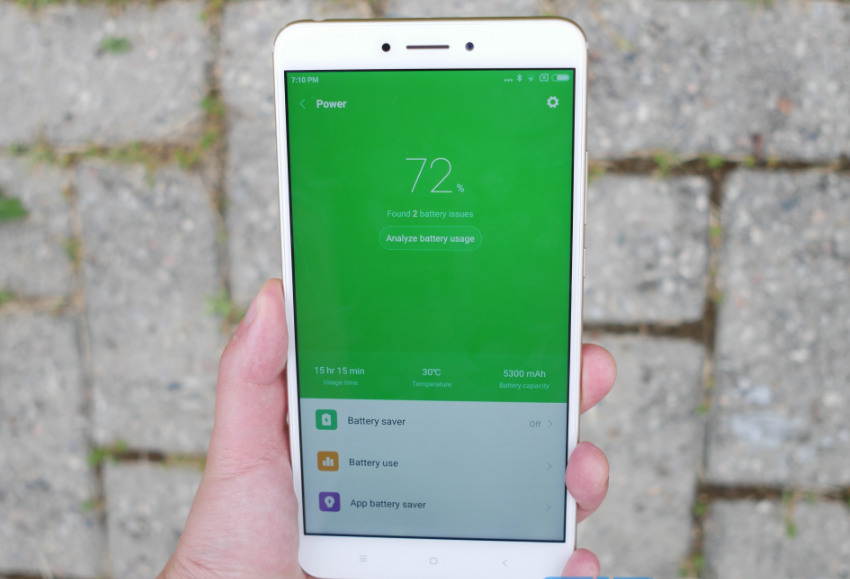
The only thing the developer has tried to do is the display frame. In the new product, it is 53% thinner than that of the Mi Max. But the picture at a strong tilt angle of the phablet began to be inverted. If you tilt the Mi Max 2 to the side, the characteristic yellowness of white immediately catches your eye.
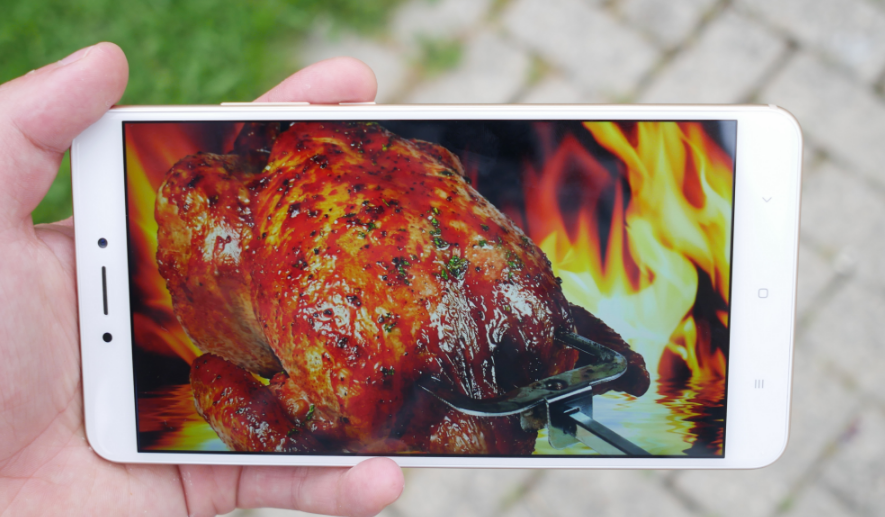
The phablet screen got a few useful functions... Among them are eye protection mode and interactive color temperature adjustment. Soon, the developers promise an update that will make it possible to use split screen in applications. For the convenience of one-handed operation, the main functional elements of the display are displaced to one corner.
Performance
The hardware of the smartphone has become a big disappointment for many Xiaomi fans. The Mi Max 2 did not receive the promised Snapdragon 660 and was honored with the familiar 625 chipset. The buyer can choose from two options with 64 or 128 GB of internal memory + 4 GB of RAM. The video accelerator Adreno 506 is responsible for the graphics.
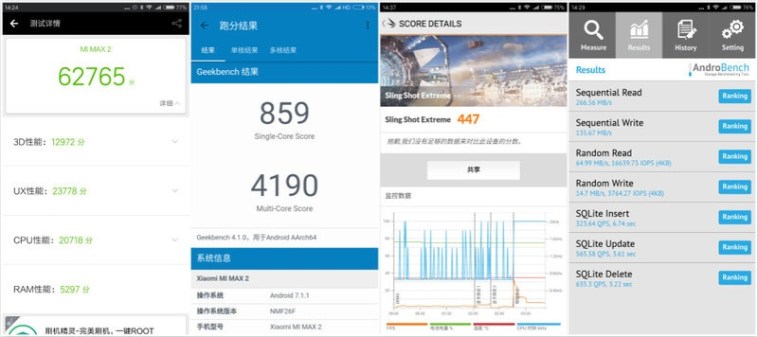
This choice of processor has both positive and negative aspects. Snapdragon 625 is slightly more energy efficient in older versions of the chipset. At the same time, he loses almost 20 thousand "parrots" in the Antutu 650 benchmark to the dragon. It turned out very strange, the already outdated smartphone is about 1/4 more powerful than the new item. So the owners of Mi Max should think before going to the store for a new device about the advisability of an upgrade.
Camera
At the presentation of the phablet, the head of Xiaomi, Lei Jun, announced the use of a Sony IMX386 photo sensor in the device's camera. It has already been used before in Mi6 and showed pretty good results. The Mi Max 2's 12-megapixel f / 2.2 main camera has PDAP support and improved low-light shooting algorithm.

However, the presence of the same sensor does not mean that the quality of photos is identical to the Mi6. This indicator is also influenced by the individual characteristics of the lenses and optimization. software processing images. Overall, the Mi Max 2 handles footage quite well in normal daylight conditions. HDR mode works great when shooting against light sources.
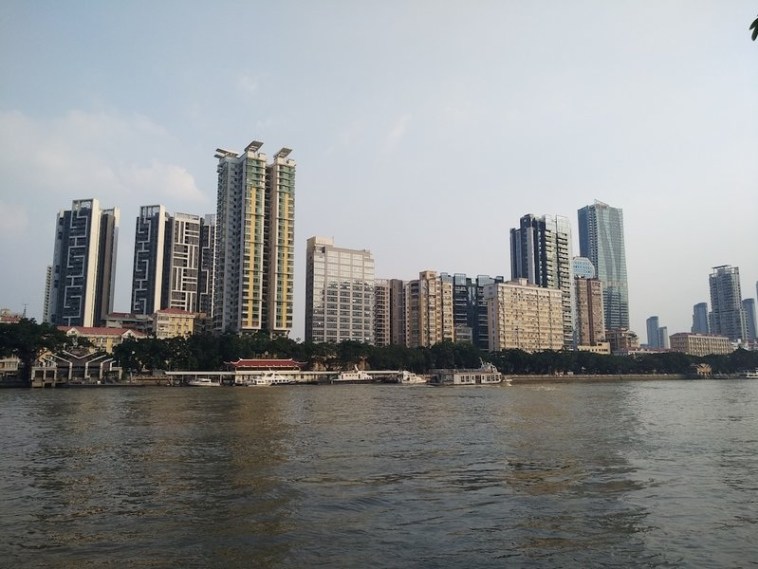


A 5-megapixel module on the front panel is responsible for selfies. Considering the cost of the device, the quality of the front camera leaves much to be desired due to mediocre detail.
Speaker, sound quality
The promised stereo sound is also disappointing. If the lower speaker still copes with its task, then the earpiece sags noticeably at high volume, which makes the sound feel uneven.
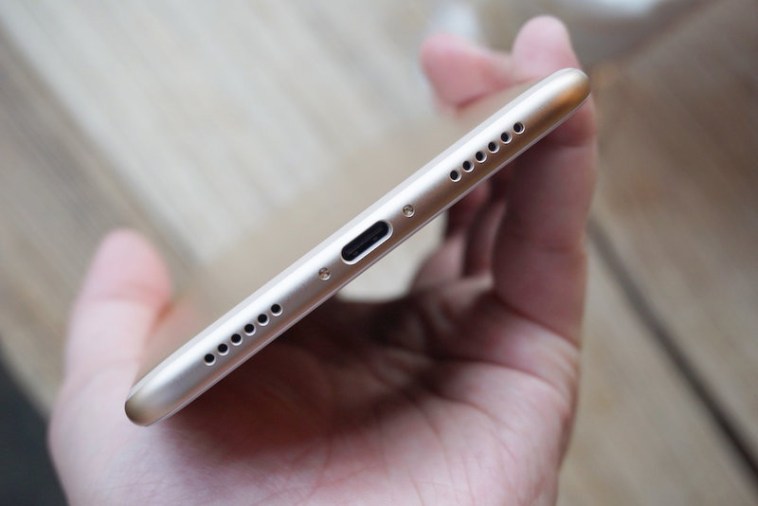
However, the spoken speaker performs its immediate tasks perfectly. The interlocutor can be heard in any conditions, as well as skip incoming call with a loudly screaming Mi Max 2, you will not be able to even in a noisy place.
Battery
Mi Max 2 packs a massive 5300mAh battery. Paired with an energy efficient processor, this is enough for one and a half to two days of active use of the smartphone. With continuous video playback at 50% screen brightness, the battery lasts almost 16 hours, and in gaming sessions it lasts for 6-7 hours - this is a very decent indicator for a 6.44-inch display.
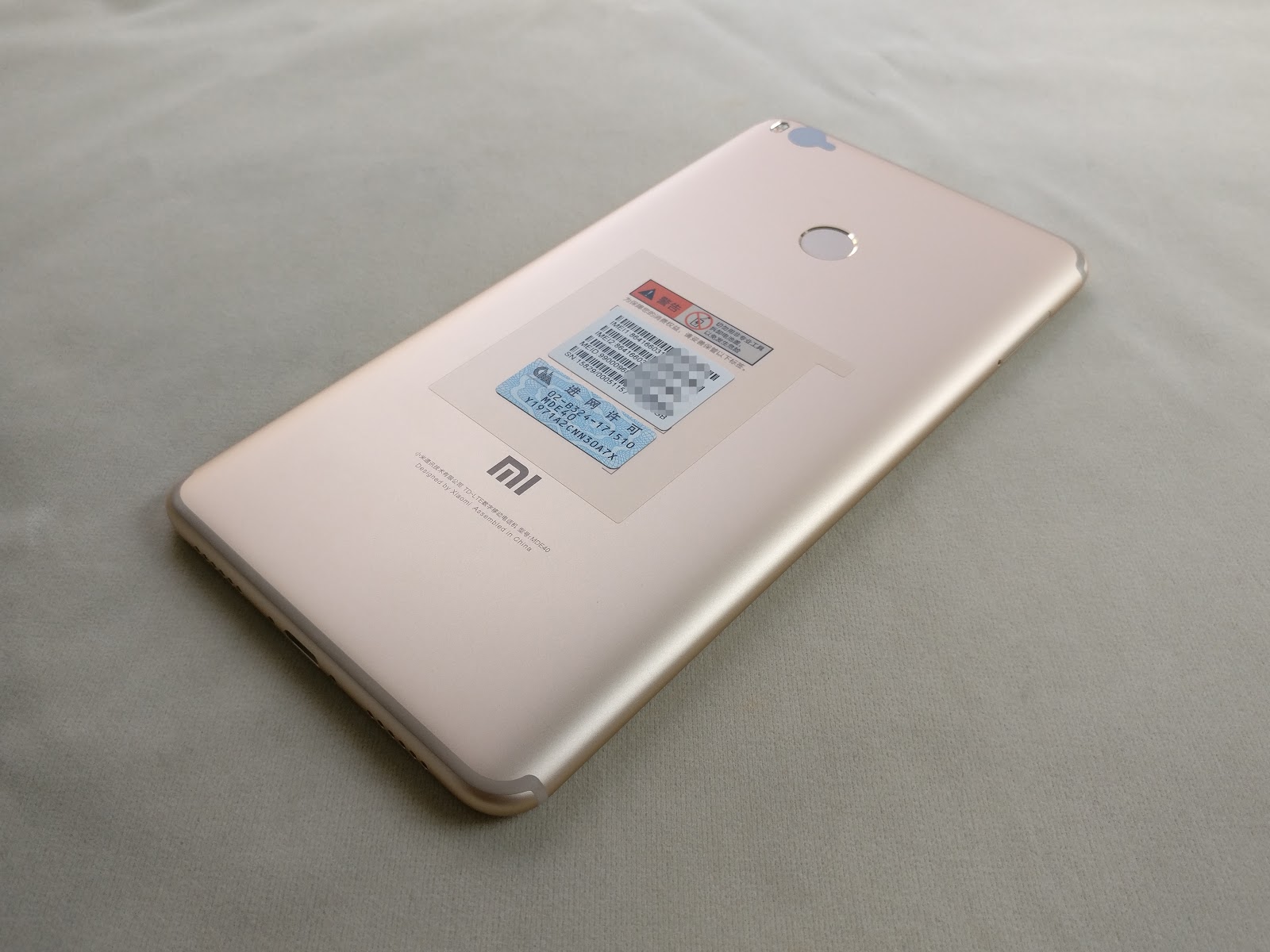
The battery supports the ability fast charging Quick Charge 3.0, also from MiMax, you can charge other smartphones using an OTG adapter. It takes 2 hours 24 minutes to fully charge the phablet.
Communication and Internet
The smartphone has Bluetooth 4.2 and excellent GPS module... The device easily finds the desired satellite and works stably with both GPS and GLONASS.

Mi Max 2 supports all the necessary communication standards for comfortable use in the CIS. During the test, there were no communication problems during a conversation with the interlocutor.
Video review Xiaomi Mi Max 2
Competitors, conclusion
Excellent build;
Long time autonomous work;
Availability of functionality for one-handed control;
Low price.
Poor stereo sound;
"Yellowness" of the display;
The performance is worse than its predecessor.
Xiaomi Mi Max 2 looks pretty attractive on paper. His big screen could well replace the tablet, and excellent autonomy is only on hand to the device. In reality, a large screen diagonal is a very specific indicator, if you have small palms, this smartphone is definitely not your choice.
The decision to use Snapdragon 625 instead of 660 is bewildering: Mi Max 2 turned out to be worse than its predecessor in terms of performance. So it's not worth updating from Mi Max to it, however, as an independent purchase of Mi Max 2, it definitely deserves attention.
In contact with
classmates




